11 Modes
We have already learned about the major mode and the minor mode. In this chapter, we learn about the seven diatonic modes as well as two pentatonic modes.
11.1 ALL-WHITE-KEY MODES
Listen to Example 11.1.1, which was written by Guillaume du Fay in 1452.
EXAMPLE 11.1.1. Du Fay[1], Missa se la face ay pale, Sanctus

Based on the key signature, does the music sound like it is in C major or A minor? Looking at the first lowest note and the last note, neither C or A seem to fit as the tonic. The tonic appears to be F. However, both the key signatures of F major and F minor also do not fit. How can we explain this example?
Modes tell us the collection of pitches used in a particular piece or section of work. For example, in the key of F major, the tonic is F and the mode is major. The mode tells us that the collection of pitches includes F–G–A–B-flat–C–D–E–F. There are more modes than only the major and minor modes. In fact, the diatonic modes (also referred to as church modes) are even older than the major and minor modes: they have been around since the Middle Ages. It was not until centuries later when tonality would evolve, converting two of the diatonic modes into the major and minor modes. Example 11.1.1 is in a diatonic mode called F Lydian.
We learned that a diatonic scale used every letter name once and only once. The major and natural minor scales (from which the major and minor key signatures are based) use diatonic scales made of only minor seconds (half steps) and major seconds (whole steps). Similarly, scales from the diatonic modes use every letter name only once and are also made with only minor seconds and major seconds. Because the names of modes come from locations in Greece, their names are always capitalized (unlike major and minor).
There are several ways to understand the diatonic modes. The first method is to relate the seven diatonic modes to all-white-key scales on the piano. For example, if you start with C4 and ascend to C5 using only the white keys, it creates the C-Ionian scale. If you start with D4 and ascend to D5 using only the white keys, it creates the D-Dorian scale, and so on (Example 11.1.2).
Example 11.1.2. All-White-Key modes
Ionian: From C to C
Dorian: From D to D
Phrygian: From E to E
Lydian: From F to F
Mixolydian: From G to G
Aeolian: From A to A
Locrian: From B to B
This method of learning diatonic modes is called the all-white-key mode method. Using this method, you associate the mode with the scale that uses only white keys on the keyboard (Example 11.1.3).
Example 11.1.3. All-White-Key Scales
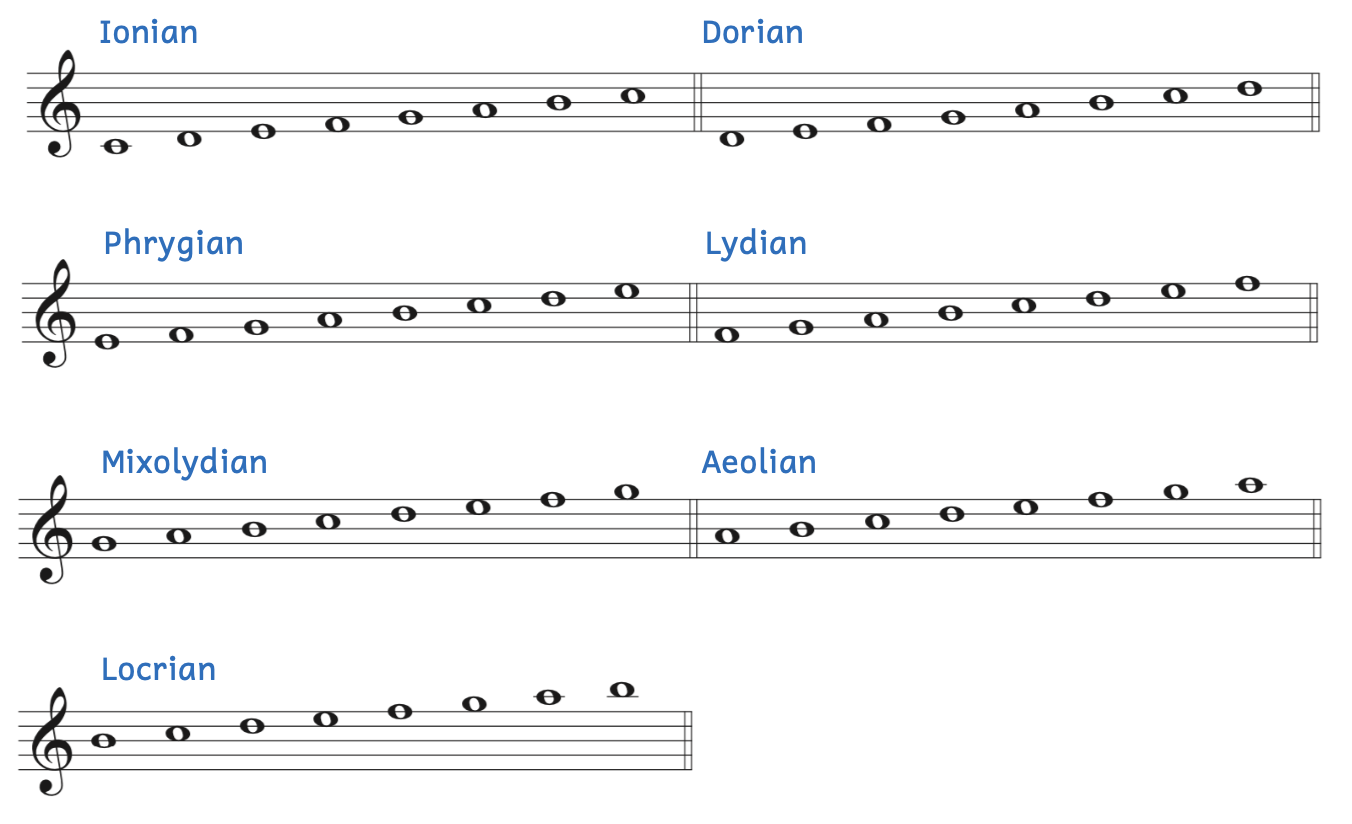
You may have noticed that two of the diatonic modes look familiar: The C-Ionian scale and the A-Aeolian scale look like the C-major scale and A-minor scale. Indeed, the major and minor modes evolved from the Ionian and Aeolian modes. However, the major and minor modes diverted from the diatonic modes with their use of tonality. There are specific characteristics that define a piece as being in a major or minor key. For example, the leading tone’s desire to resolve up to tonic is a tonal quality. This tonal characteristic is missing from music using diatonic modes (Example 11.1.4).
Example 11.1.4. Minor versus Aeolian
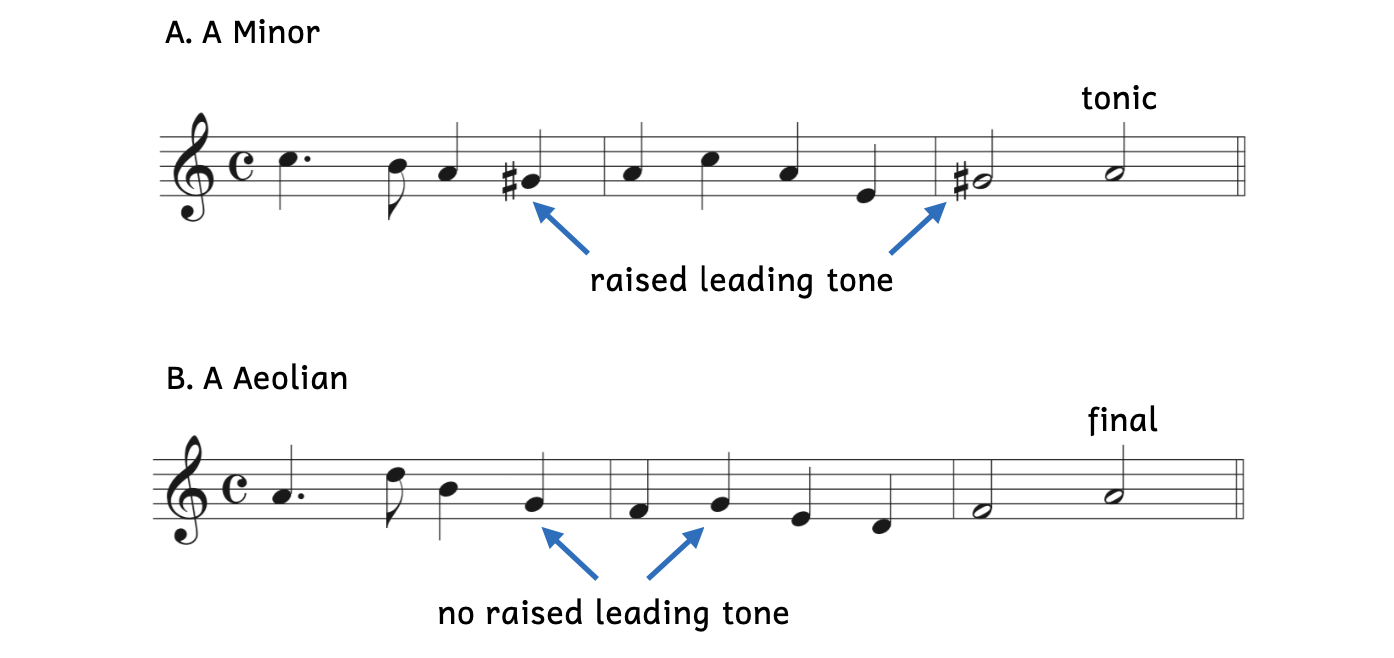
Although the contours are similar, there are several significant differences between the two melodies. In the example in A minor (Example 11.1.4A):
- The subtonic (G) is raised to become the leading tone (G-sharp).
- The leading tone plays an important role to establish and confirm A minor.
- Both times, the leading tone resolves up to the tonic.
- The melody ends on the tonic, preceded by the leading tone.
In the example in A Aeolian (Example 11.1.4B):
- There is no raised subtonic (i.e., there is no leading tone). The leading tone stems from tonality, where the pull from [latex]\hat7[/latex] to [latex]\hat1[/latex] defines tonal music. (The name “leading tone” means to “lead to tonic”.)
- In addition to the subtonic not being raised, it does not resolve to tonic. The first time, G steps down to F and the second time, G skips down to E.
- With the lack of tonality, the melody does not end on the tonic. Instead, it ends on the final (from Latin, finalis). In tonality, [latex]\hat1[/latex] is called the tonic whereas for the diatonic modes, [latex]\hat1[/latex] is called the final. The final is nearly always the last note of the piece.
Just as we did with major and minor modes, we include both the tonic (or final) and the mode when analyzing a musical example (e.g., E minor or E Phrygian).
Using the all-white-key mode method, what is the mode of the following example (Example 11.1.5)?
Example 11.1.5. Mode example[2]

- Looking at the last note, the final is D.
- There are no accidentals and the key signature has no sharps or flats—this excerpt uses only the white keys on the keyboard.
- For these two reasons, we can conclude that Example 11.1.5 is in D Dorian.
Béla Bartók wrote a collection called Mikrokosmos, which consists of 153 progressive piano pieces. A number of the movements are excellent examples of modes and are even named after the modes themselves (Example 11.1.6).
Example 11.1.6. Bartók[3], Mikrokosmos
A. No. 34, “In Phrygian Mode”

B. No. 37, “In Lydian Mode”

C. No. 48, “In Mixolydian Mode”

In the three Bartók examples above, each one is in an all-white-key mode.
- Example 11.1.6A is in E Phrygian.
- Example 11.1.6B is in F Lydian.
- Example 11.1.6C is in G Mixolydian.
Listen to each example to hear the different qualities of the modes.
If you use the all-white-key method, it is extremely helpful to memorize the order of diatonic modes. You can use a mnemonic to help you memorize the order of modes: IDPLMAL (Ionian, Dorian, Phrygian, Lydian, Mixolydian, Aeolian, Locrian). Some mnemonics include:
- I Dodge Physics Like Mice Avoid Locks
- I Doubt Physicians Like Mowing A Lawn
- Indubitably, Dolly Parton Loved Music A Lot
- I Don’t Play Leopold Mozart After Lunch
- I Don’t Phrase Like Mix-A-Lot
- I Drink Pink Lemonade Mostly At Lunch
- In Denver, People Like Mountains And Lakes
All-White-Key Modes
One way to think of the modes is to remember which modes belong to all-white-key scales. Starting from C to C, the order of modes is Ionian, Dorian, Phrygian, Lydian, Mixolydian, Aeolian, and Locrian.
Practice 11.1A
Directions:
- Write the mode for the following all-white-key scales.
Sample C to C: Ionian
- G to G:
- E to E:
- D to D:
- A to A:
- B to B:
- F to F:
Solution
Practice 11.1B
Directions:
- Using the all-white-key mode method, label the final and mode for each example (e.g., F Lydian).[4]
1. _________________________________________

2. _________________________________________

3. _________________________________________

4. _________________________________________

Click here to watch the tutorial.
Solution
11.2 MODES WITH MI
Recall that the unique difference between major and minor is the mediant: [latex]\hat3[/latex]. Because the minor mode also uses the harmonic and melodic minor scales, [latex]\hat6[/latex] can be le ([latex]\hat6[/latex]) or la (raised [latex]\hat6[/latex]) and [latex]\hat7[/latex] can be te ([latex]\hat7[/latex], the subtonic) or ti (raised [latex]\hat7[/latex], the leading tone). However, [latex]\hat3[/latex] is always mi in major and always me in minor. For this reason, you can identify modes based on the quality of the third in the scale.
- If the third is a major third, it is a mode with mi. This is the third found in the major scale.
- If the third is a minor third, it is a mode with me. This is the third found in all the minor scales.
In Chapter 8, we learned about a shortcut to quickly identify major thirds and minor thirds (Chapter 8, Section 7). We started from first identifying the all-white-key major thirds.
Example 11.2.1. All-white-key major thirds

The all-white-key major thirds begin on C, F, and G. The all-white-key modes built on C, F, and G are also the modes with a major third (mi).
Example 11.2.2. Modes with mi
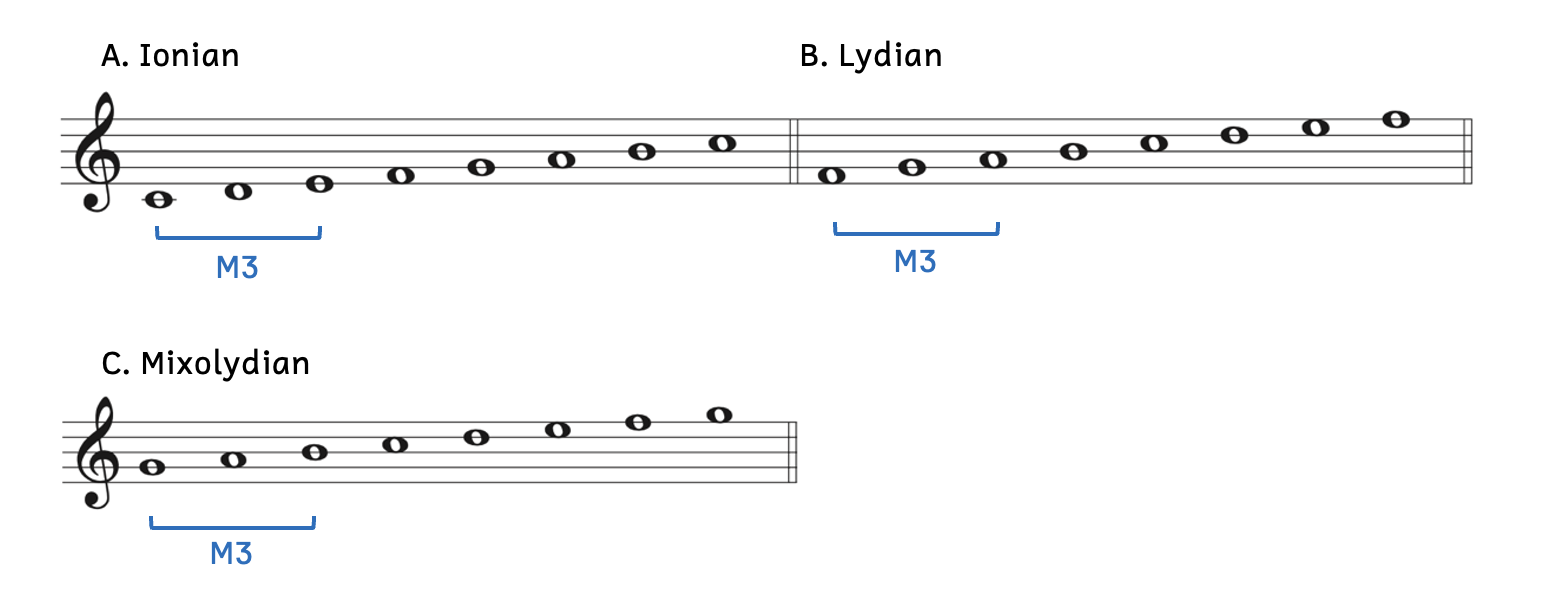
The three modes with a major third above the final are Ionian, Lydian, and Mixolydian. To simplify things, this book refers to these three modes as mi-modes. If you prefer, you can refer to them as the modes with a major third above the final.
As already mentioned, the Ionian scale contains the same pitches as the major scale. However, the Lydian and Mixolydian scales differ from the F-major and G-major scales. How do they differ?
Example 11.2.3. How mi-modes differ from major

- Example 11.2.3A: The C-Ionian scale contains the same pitches as the major scale.
- Example 11.2.3B: The F-Lydian scale differs from the major scale because of the raised [latex]\hat4[/latex] (fi). Everything else is the same as F major.
- Example 11.2.3C: The G-Mixolydian scale differs from the major scale because of the lowered [latex]\hat7[/latex] (te). Everything else is the same as G major.
Listen to the Lydian scale (Example 11.2.3B) and the Mixolydian scale (Example 11.2.3C). Do you hear how they are different from their major counterpart? We can apply these two alterations to a C-major scale and create a C-Lydian scale and C-Mixolydian scale. By rewriting these modes with the final of C, we can clearly see which notes are altered.
Example 11.2.4. C Lydian and C Mixolydian

- Example 11.2.4A: Raised [latex]\hat4[/latex] within a C Ionian (major) scale shows that F is raised to F-sharp.
- Example 11.2.4B: Lowered [latex]\hat7[/latex] within a C Ionian (major) scale shows that B is lowered to B-flat.
Notice that when there is only one sharp, it is F-sharp, and when there is only one flat, it is B-flat. The sharps and flats will appear in the same order as they did with major and minor key signatures. That is, if you have three flats, they will always be B-flat, E-flat, and A-flat.
Also like the major scales and the natural minor scales, the modes will never have double sharps or double flats. Moreover, a mode will never have both a sharp and a flat.
When constructing scales of modes, simply write the major scale and make the necessary alterations. Example 11.2.5 shows the steps to writing a descending E-Mixolydian scale.
Example 11.2.5. Steps to writing a scale in a diatonic mi-mode
A. Step one. Write a descending E-major scale using accidentals:

B. Step two. For the Mixolydian scale, lower [latex]\hat7[/latex]:

- Example 11.2.5A: Step one: Because the Mixolydian mode is a mi-mode, we begin by writing a descending major scale with accidentals.
- Recall that the easiest way to write a scale is to write [latex]\hat1[/latex] at the top and the bottom of the scale. Then apply the accidentals that are in the key signature for E major.
- Example 11.2.5B: Step two: Because the mode is Mixolydian, lower [latex]\hat7[/latex].
- When writing a descending scale, [latex]\hat7[/latex] is the second note—not the penultimate note.
- In E major, [latex]\hat7[/latex] is D-sharp. To lower D-sharp, it becomes D. Because there is no key signature, there is no need for a natural sign.
Notice that there are three sharps in Example 11.2.5B. Because there are three sharps, they are F-sharp, C-sharp, and G-sharp. Remember that the order of sharps and flats is the same as they are for major and minor keys.
In Palestrina’s “Canticum canticorum,” the use of a G-Mixolydian scale is clearly used (Example 11.2.6).
Example 11.2.6. Mixolydian scale: Palestrina[5], Motets (Book 4), “Canticum canticorum” (“Song of Songs”)
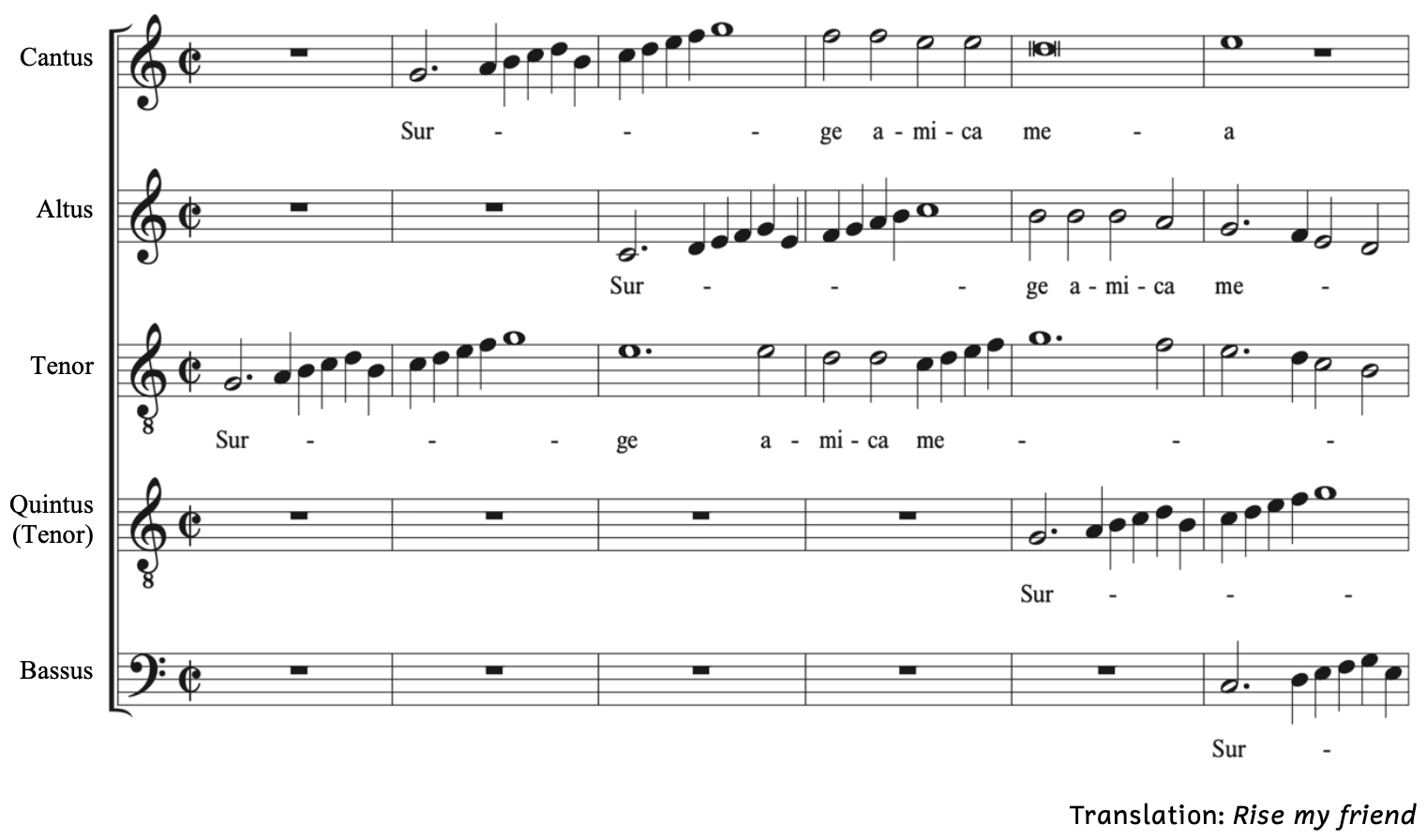
The tenors begin the movement with an ascending G-Mixolydian scale. The scale is lacking the F-sharp that belongs to G major by lowering [latex]\hat7[/latex]. The time signature in Example 11.2.6 is not a typo, as Palestrina often wrote the time signature in cut time. The clefs have been changed, however, for the convenience of reading.
Mi-Modes
There are three modes in which the third above the final is a major third (mi). To remember these modes, compare them to the major scale.
- Ionian: Same as the major scale
- Lydian: Major scale with raise [latex]\hat4[/latex] (fi)
- Mixolydian: Major scale with lowered [latex]\hat7[/latex] (te)
Practice 11.2A
Directions:
- Identify the following mi-modes by the final and mode (e.g., C Lydian).
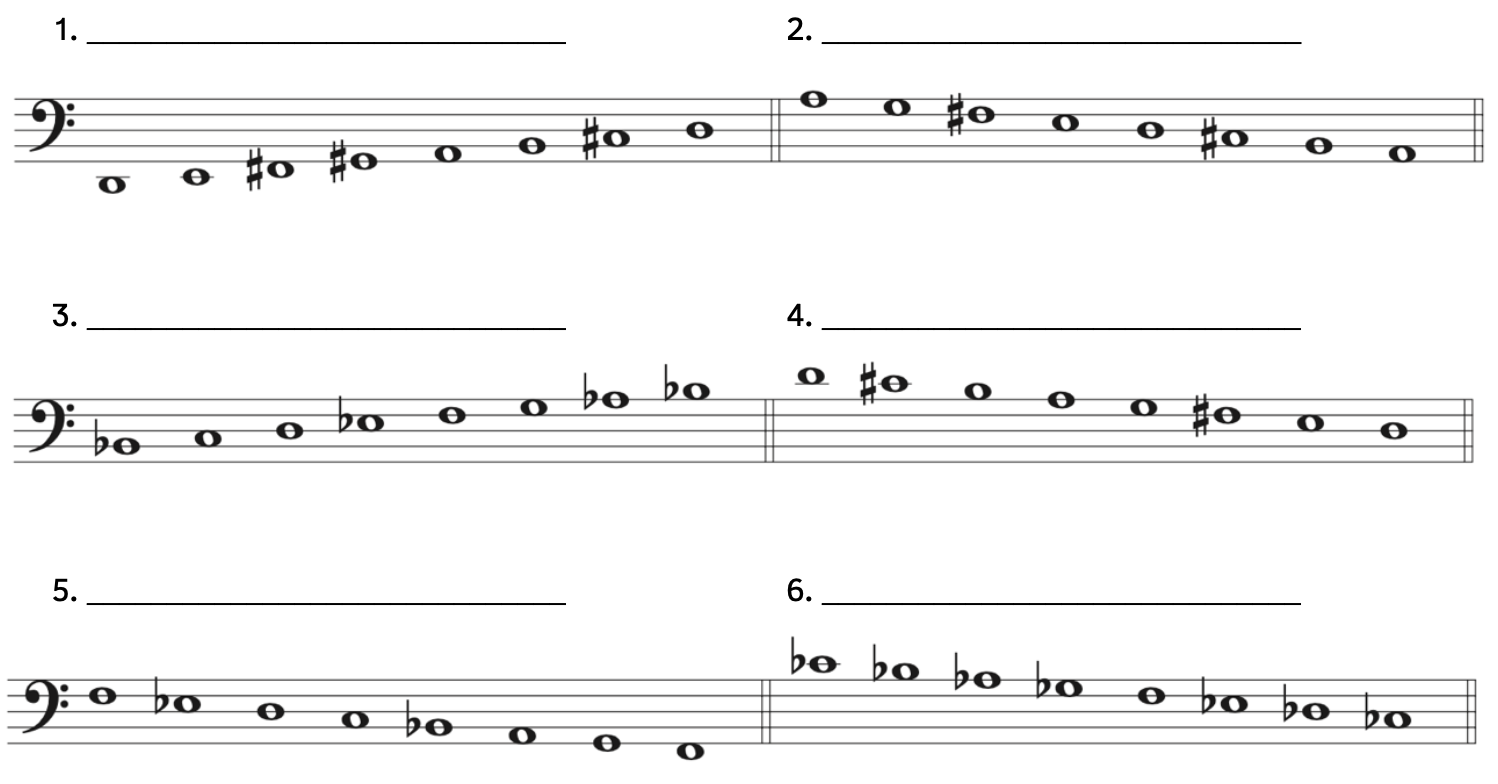
Click here to watch the tutorial.
Solution
Practice 11.2B
Directions:
- Add accidentals to construct the following scales.
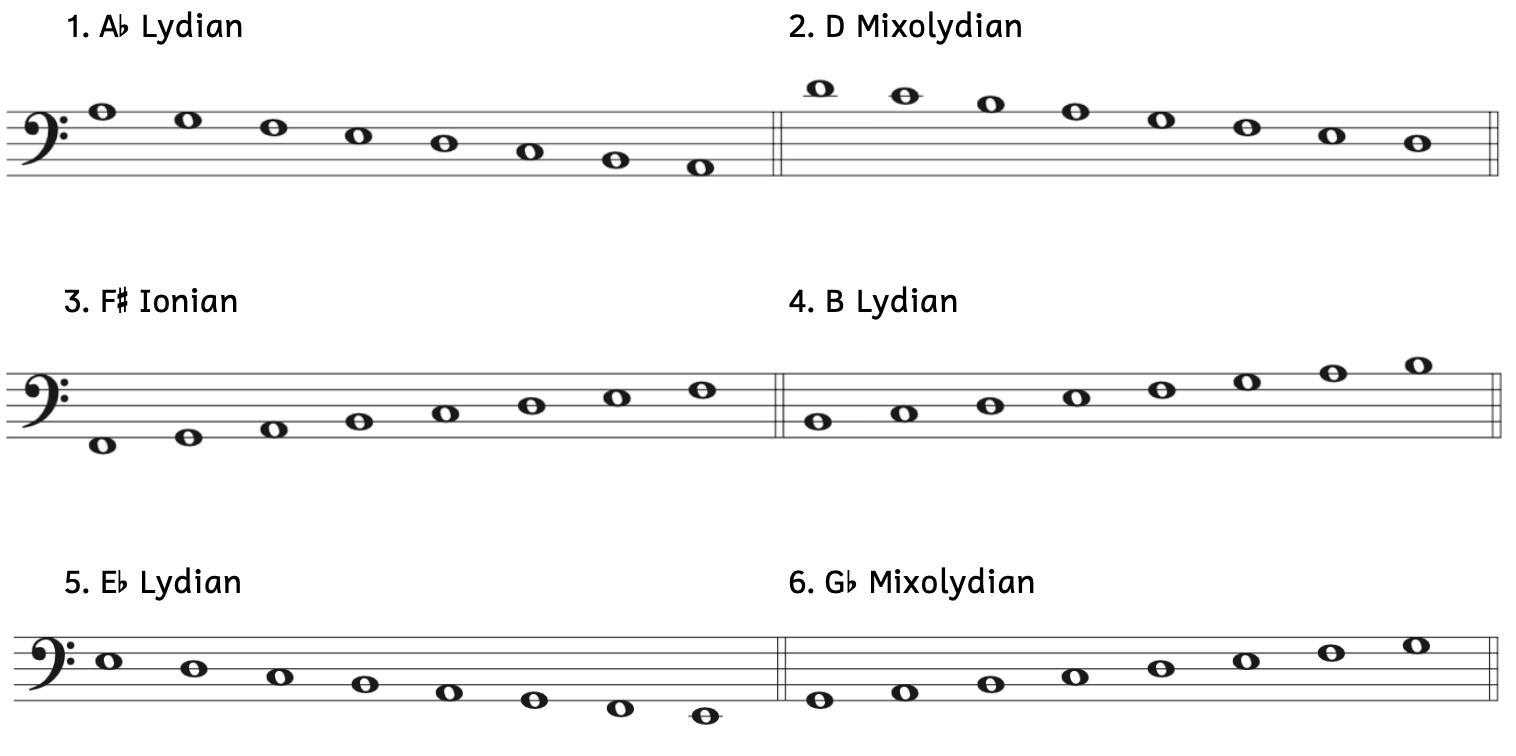
Click here to watch the tutorial.
Ways to Double Check Your Answers
- Make sure you use each pitch (letter) name once and only once.
- If the first note has an accidental, the last note must also have an accidental.
- Modes never have double sharps or double flats, and modes never combine sharps and flats.
- The accidentals are always in the same order as how they appeared in the major and minor key signatures. For example, if you have two sharps, they will always be F-sharp and C-sharp; they will never be F-sharp and G-sharp.
11.3 MODES WITH ME
In Chapter 8, we learned about the all-white-key minor thirds (Chapter 8, Section 7).
Example 11.3.1. All-white-key minor thirds

The all-white-key minor thirds begin on D, E, A, and B. The all-white-key modes built on D, E, A, and B are also the modes with a minor third (me).
Example 11.3.2. Modes with minor thirds
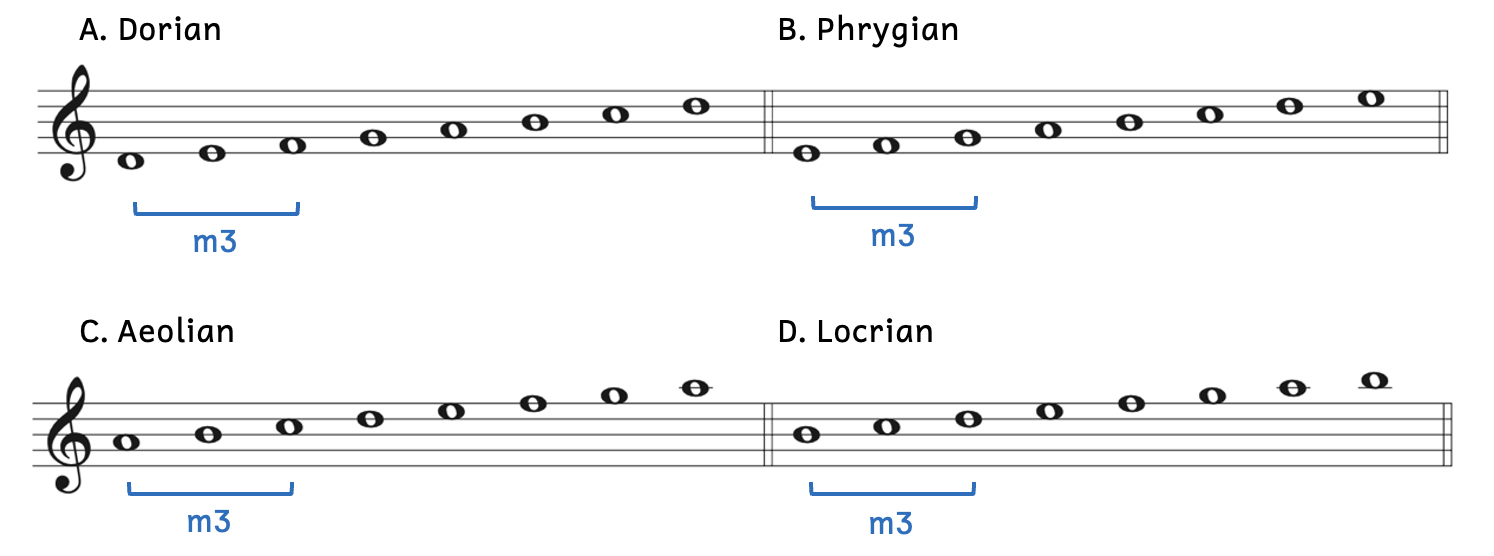
The four modes with a minor third above the final are Dorian, Phrygian, Aeolian, and Locrian. To simplify things, this book refers to these four modes as me-modes. If you prefer, you can refer to them as the modes with a minor third above the final.
As already mentioned, the Aeolian scale contains the same pitches as the natural minor scale. However, the Dorian, Phrygian, and Locrian scales differ from the D-minor, E-minor, and B-minor scales. How do they differ?
Example 11.3.3. Difference between me-modes and the natural minor scale
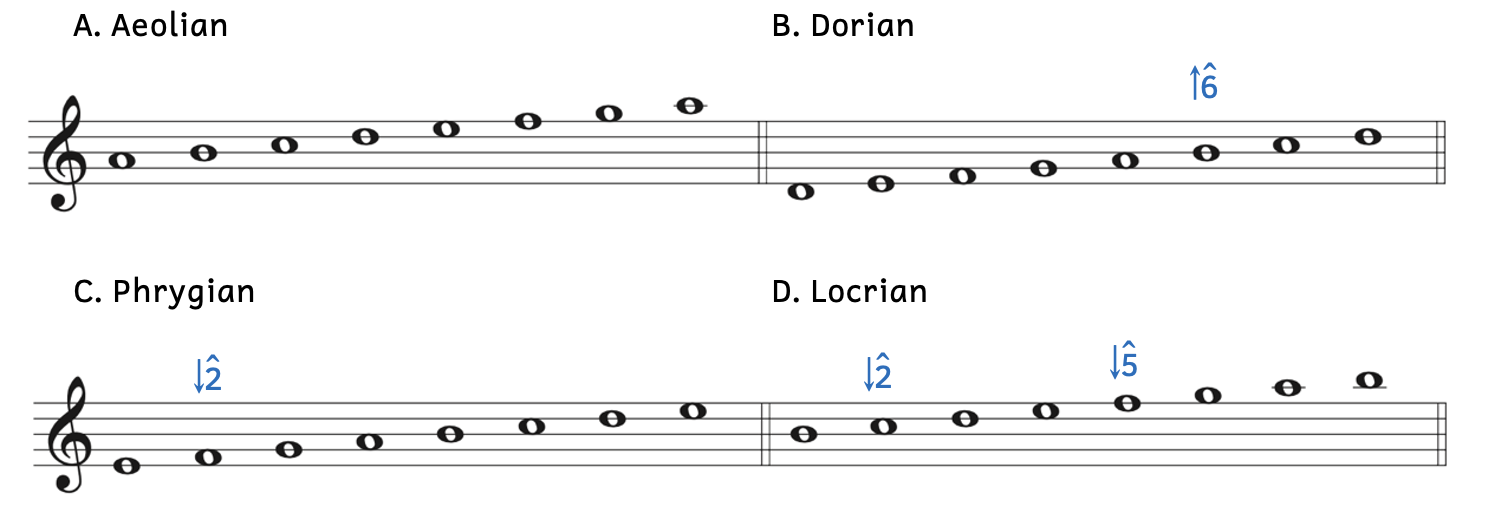
- Example 11.3.3A: The A-Aeolian scale contains the same pitches as the natural minor scale.
- Example 11.3.3B: The D-Dorian scale differs from the natural minor scale because of the raised [latex]\hat6[/latex] (la). Everything else is the same as D minor.
- Example 11.3.3C: The E-Phrygian scale differs from the natural minor scale because of the lowered [latex]\hat2[/latex] (ra). Everything else is the same as E minor.
- Example 11.3.3D: The B Locrian scale is the only mode with two alterations. It differs from the natural minor because of the lowered [latex]\hat2[/latex] (ra) and lowered [latex]\hat5[/latex] (se). Everything else is the same as B minor.
We can apply these alterations to an A natural minor scale to create a Dorian, Phrygian, and Locrian scale. From A natural minor, the alterations are more clear (Example 11.3.4).
Example 11.3.4. A Dorian, A Phrygian, and A Locrian

Just as for major keys, minor keys, and the mi-modes, the order of accidentals for the me-modes is also the same.
- Example 11.3.4A: Raising [latex]\hat6[/latex] results in one sharp, which is F-sharp.
- Example 11.3.4B: Lowering [latex]\hat2[/latex] results in one flat, which is B-flat.
- Example 11.3.4C: Lowering [latex]\hat2[/latex] and [latex]\hat5[/latex] results in two flats, which are B-flat and E-flat.
When constructing scales of me-modes, simply write the natural minor scale and make the necessary alterations. For example, write an ascending B-Dorian scale.
Example 11.3.5. Steps to writing a scale in a diatonic me-mode
A. Step one. Write an ascending B-minor scale using accidentals.

B. Step two. For a Dorian scale, raise [latex]\hat6[/latex]:

- Example 11.3.5A: Because Dorian is a me-mode, we begin with writing an ascending natural minor scale with the accidentals in the key signature of B minor.
- Example 11.3.5B: Because the mode is Dorian, raise [latex]\hat6[/latex].
- In B minor, [latex]\hat6[/latex] is G. To raise G, add a sharp.
Notice that there are three sharps in B Dorian (as opposed to only two in B minor). The three sharps are F-sharp, C-sharp, and G-sharp.
In only ten measures, Debussy includes four instances of modes in “Fêtes” (“Festivals”) (Example 11.3.6).
Example 11.3.6. Modal scales: Debussy[6], Nocturnes No. 2, “Fêtes” (“Festivals”)
A. Measure 156: B-flat Phrygian

B. Measure 160: B-flat Mixolydian

C. Measure 164: C-sharp Phrygian

D. Measure 165: G-sharp Locrian

The examples above are played by the second violins. The first violins and violas also have the same melody, but the first violins play an octave higher and the second violins play an octave lower.
- Example 11.3.6A: The upper strings play a B-flat Phrygian scale. Because the key signature is that of B-flat minor, locating the lowered [latex]\hat2[/latex] of the Phrygian scale is easy to see.
- Example 11.3.6B: The upper strings play a B-flat Mixolydian scale. This time, several accidentals need to be added, including D-natural and G-natural. What results is a B-flat major scale with lowered [latex]\hat7[/latex] (A-flat).
- Example 11.3.6C: The upper strings play a C-sharp Phrygian scale. C-sharp Phrygian has no shared notes with the key signature, so accidentals are placed on every note.
- Debussy could have used C-sharp’s enharmonic equivalent, D-flat. The D-flat Phrygian scale would have only required one accidental with the given key signature.
- Example 11.3.6D: The upper strings play a G-sharp Locrian scale. The notes belong to a G-sharp natural minor scale, except that [latex]\hat2[/latex] (A-sharp) and [latex]\hat5[/latex] (D-sharp) have been lowered to A-natural and D-natural.
There are more examples of modes in Debussy’s “Fêtes.” Take a moment to listen to the piece with the score and see how many more you can find.
Me-Modes
There are four modes in which the third above the final is a minor third (me). To remember these modes, compare them to the natural minor scale.
- Aeolian: Same as the natural minor scale
- Dorian: Natural minor scale with raised [latex]\hat6[/latex] (la)
- Phrygian: Natural minor scale with lowered [latex]\hat2[/latex] (ra)
- Locrian: Natural minor scale with lowered [latex]\hat2[/latex] (ra) and lowered [latex]\hat5[/latex] (se)
Practice 11.3A
Directions:
- Identify the following me-modes by the final and mode (e.g., C Dorian).
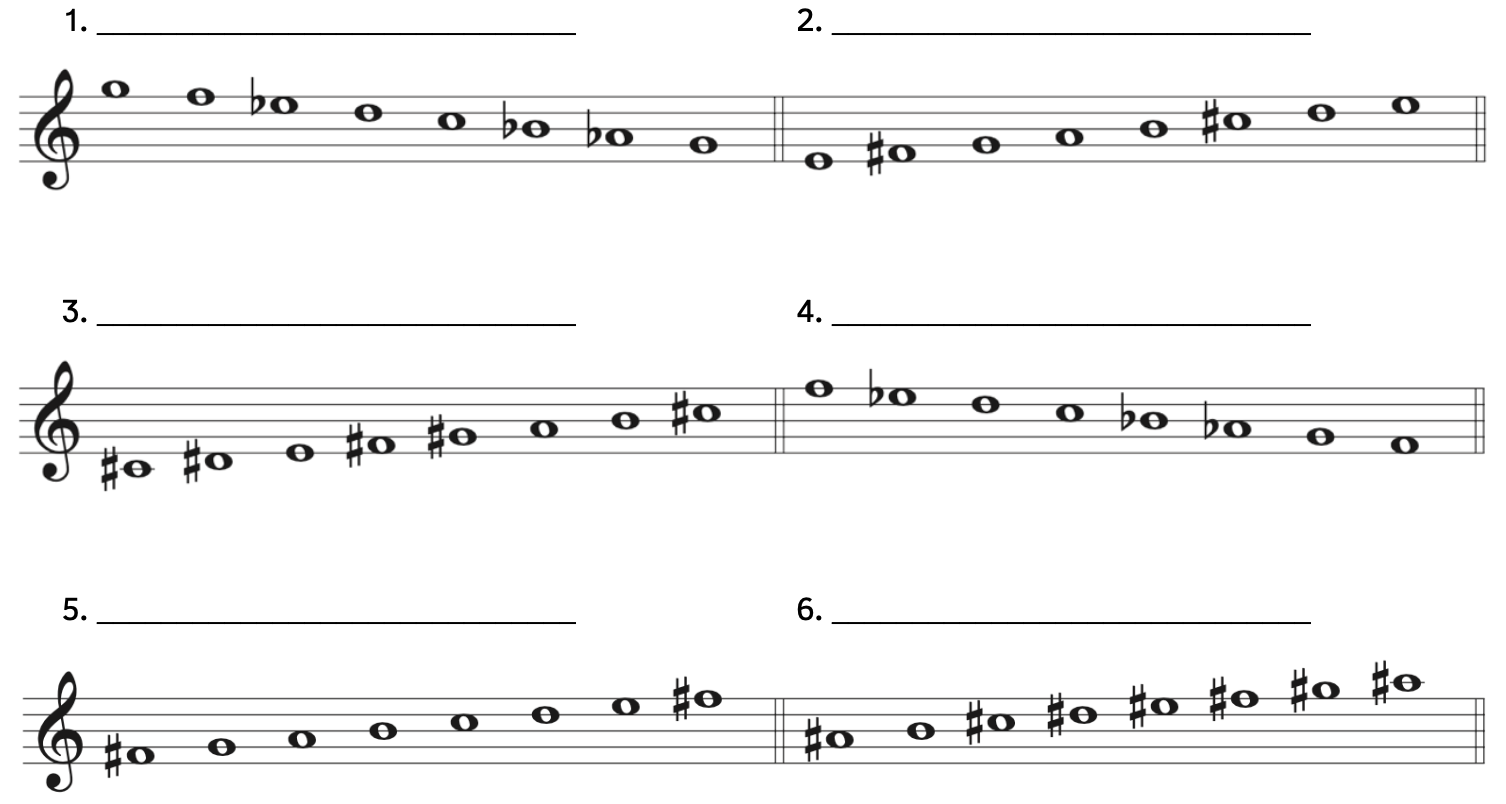
Click here to watch the tutorial.
Solution
Practice 11.3B
Directions:
- Add accidentals to construct the following scales.
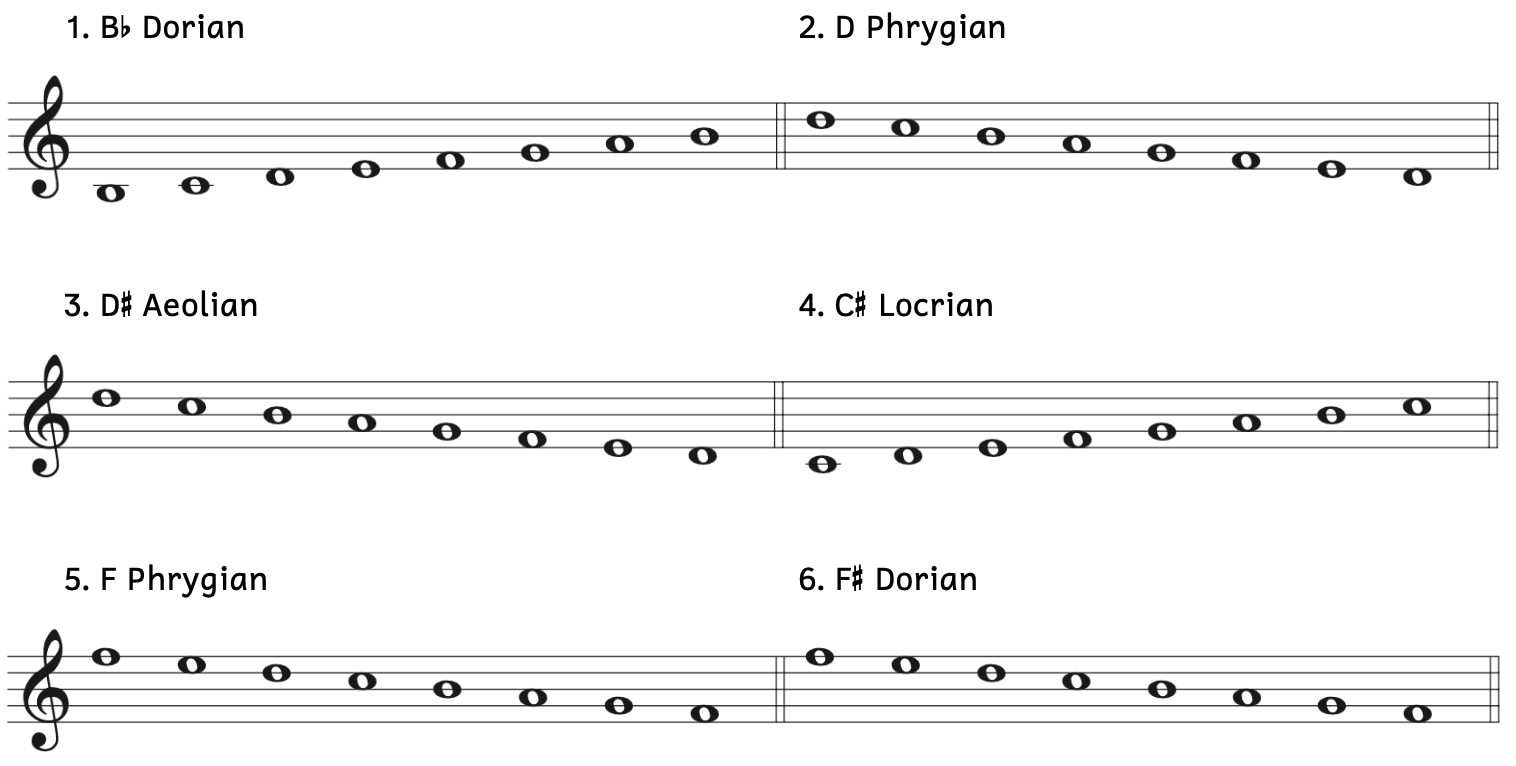
Click here to watch the tutorial.
Identifying Scales with Mi or Me
Now that we learned about both mi-modes and me-modes, let’s practice identifying a mode step by step.
Example 11.3.7. Identify the mode of this scale

- Identify the third: Is it a major third or a minor third? The third in Example 11.3.7 is a major third (mi-mode).
- Now that we know it is a mi-mode, how does the scale differ from an A-major scale?
- A major has three sharps.
- Example 11.3.7 has four sharps.
- This means that [latex]\hat4[/latex] is raised compared to A major.
- Since Example 11.3.7 is like a major scale but [latex]\hat4[/latex] is raised, this is an A-Lydian scale.
Although we identified that [latex]\hat4[/latex] is raised, we do not need to look for which specific note is altered; we can use a shortcut to simply check if something is raised or something is lowered. Raising a note can mean that a sharp is added or a flat is removed.
Let’s apply the shortcut to Example 11.3.8.
Example 11.3.8. Shortcut to identify the mode of this scale

- Identify the third: Is it a major third or a minor third? The third in Example 11.3.8 is a major third (mi-mode).
- Now that we know it is a mi-mode, how does the scale differ from an A-major scale?
- A major has three sharps.
- Example 11.3.8 has four sharps.
- Example 11.3.8 has one more sharp than A major, which makes the mode Lydian.
It is important to know that [latex]\hat4[/latex] is raised in the Lydian mode. However, to identify a modal scale, you simply need to know how the accidentals differ from a major or minor scale and not the specific altered scale degree.
Let’s try this shortcut to identify another mode.
Example 11.3.9. Identify the mode of this scale

- Identify the third: Is it a major third or a minor third? The third in Example 11.3.9 is a minor third.
- Now that we know it is a me-mode, how does the scale differ from a C-sharp natural minor scale?
- C-sharp minor has four sharps.
- Example 11.3.9 has three sharps. Remember that the repeated sharp on [latex]\hat8[/latex] is the same sharp as the sharp on [latex]\hat1[/latex].
- Since one sharp is removed, this means that something is lowered compared to C-sharp minor, making this a C-sharp Phrygian scale.
We know that the Phrygian mode is like the minor mode, except that [latex]\hat2[/latex] is lowered. We see that the lowered note in Example 11.3.9 is [latex]\hat2[/latex] (from D-sharp to D). However, to quickly identify the mode, we do not need to look for which note is altered; we can simply use the shortcut to check if something is raised or something is lowered.
Remember that lowering a note does not always mean adding a flat. It can also mean removing a sharp. Lowered [latex]\hat2[/latex] in Example 11.3.9 is D(-natural), not D-flat.
Identifying Modal Scales
- Identify the third as major (mi-mode) or minor (me-mode).
- How does the mode differ from the major or minor mode?
- If the third is major (mi-mode)
- Same accidentals as major >> Ionian
- Like major, but [latex]\hat4[/latex] is raised >> Lydian
- Like major, but [latex]\hat7[/latex] is lowered >> Mixolydian
- If the third is minor (me-mode)
- Same accidentals as minor >> Aeolian
- Like minor, but [latex]\hat6[/latex] is raised >> Dorian
- Like minor, but [latex]\hat2[/latex] is lowered >> Phrygian
- Like minor, but [latex]\hat2[/latex] and [latex]\hat5[/latex] are lowered >>Locrian
- If the third is major (mi-mode)
- Raising a note means adding a sharp or removing a flat
- Lowering a note means adding a flat or removing a sharp
Practice 11.3C
Directions:
- Identify the following modes by the final and mode (e.g., C Lydian). This section includes both mi-modes and me-modes.
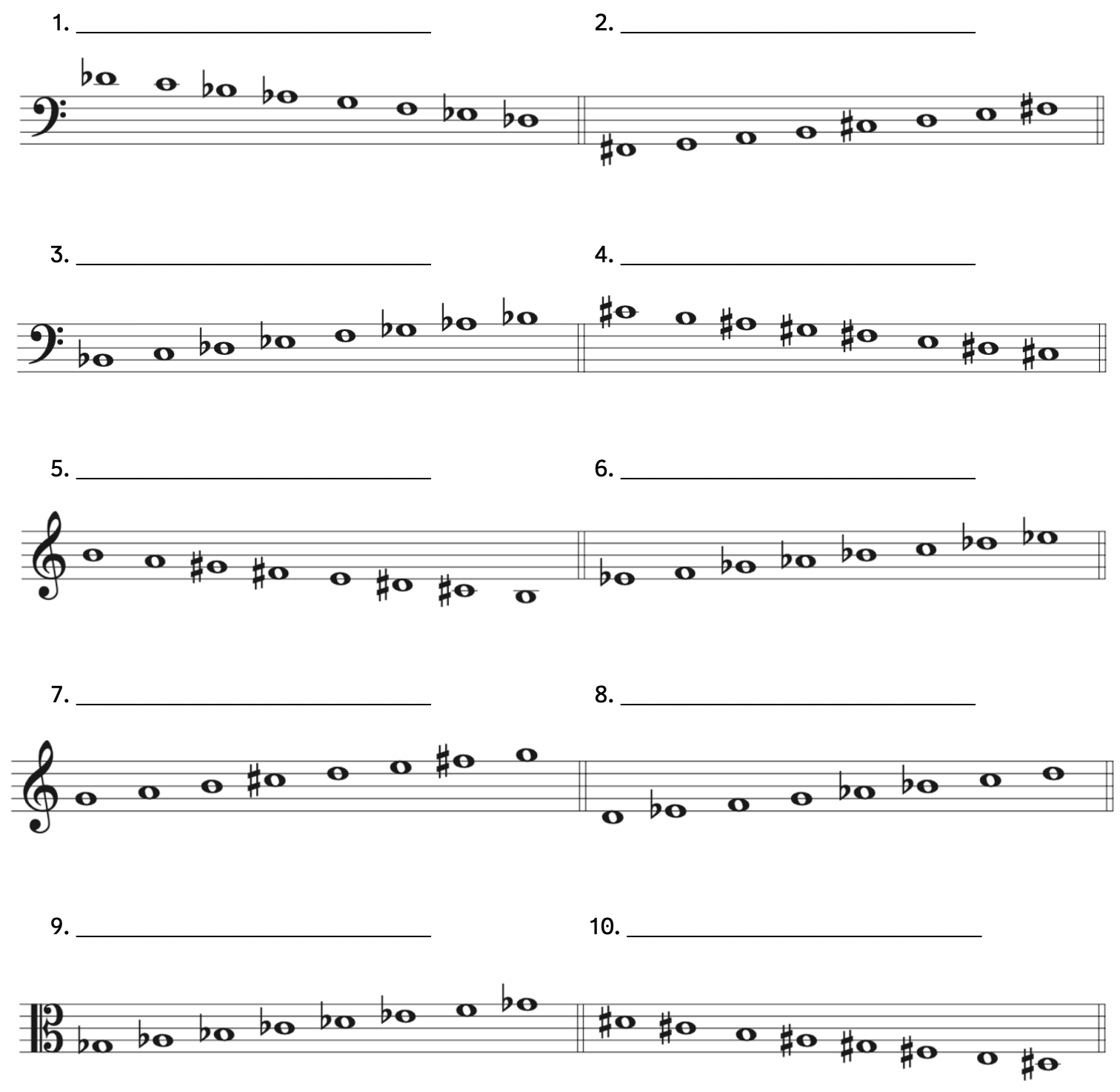
Click here to watch the tutorial.
Solution
Practice 11.3D
Directions:
- Add accidentals to construct the following scales.
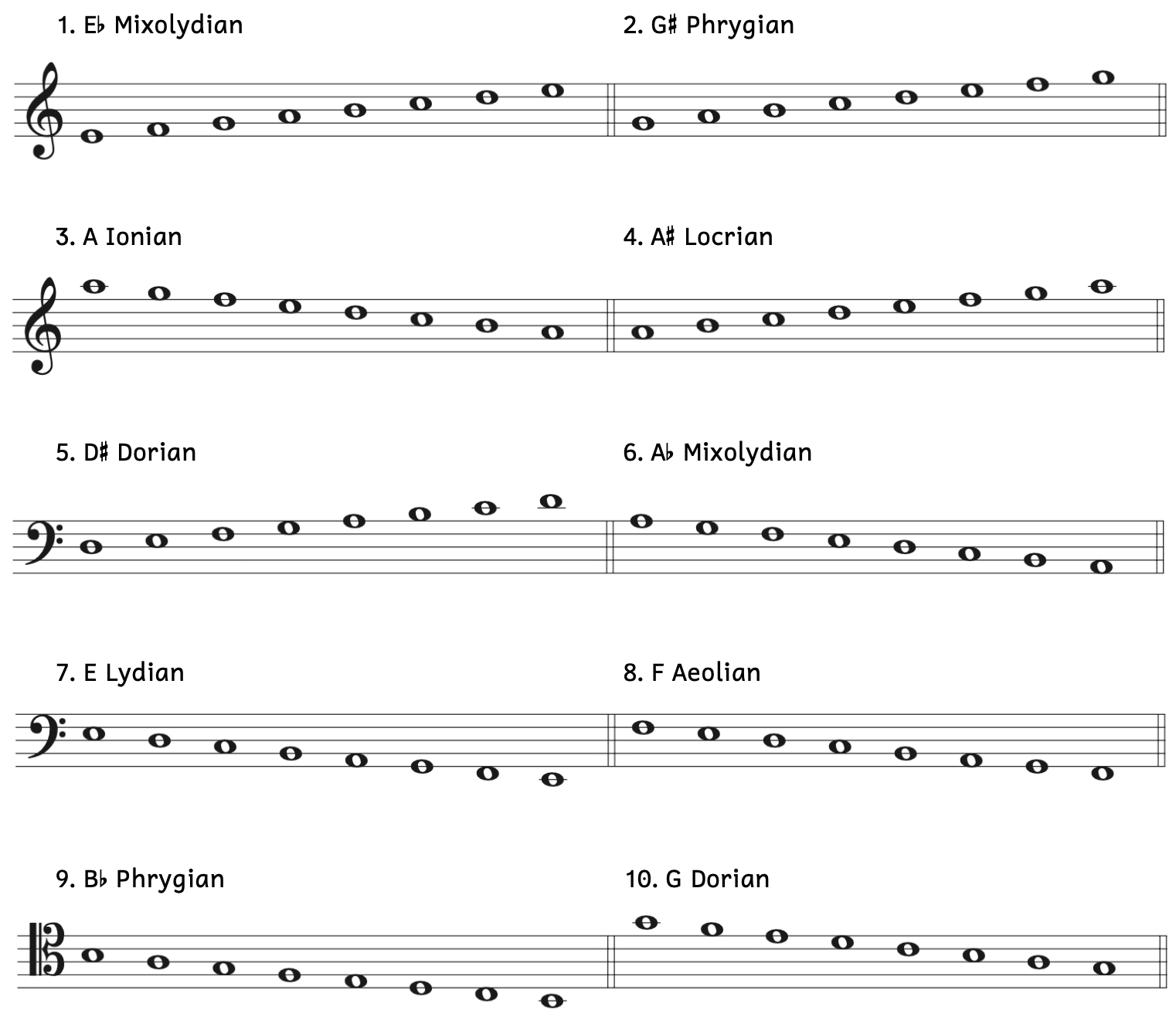
11.4 KEY SIGNATURES BASED ON MAJOR OR MINOR
In Chapter 4 (Major Scales and Keys) and Chapter 6 (Minor Scales and Keys), we learned that rather than rewriting all the accidentals in a scale, we could add a key signature instead. It was much easier to add or identify a key signature than to add or count accidentals, especially when there were many accidentals.
Similarly, modes can use key signatures. When they do, there are two methods to write and identify key signatures quickly. This section will cover the first method: key signatures based on major or minor.
Recall that there are three modes with a major third (mi-modes). For these key signatures, begin with the major key signature.
- Ionian: same key signature as major
- Lydian: same key signature as major + raised [latex]\hat4[/latex]
- Mixolydian: same key signature as major + lowered [latex]\hat7[/latex]
There are four me-modes: Aeolian, Dorian, Phrygian, and Locrian. However, the Locrian mode is far less common than any of the other modes. For this reason, the Locrian mode will not be included in this section.[7] For the key signatures of the remaining three me-modes, begin with the minor key signature.
- Aeolian: same key signature as minor
- Dorian: same key signature as minor + raised [latex]\hat6[/latex]
- Phrygian: same key signature as minor + lowered [latex]\hat2[/latex]
For the Ionian and Aeolian modes, the key signatures are the same as major and minor, respectively.
The good news about writing key signatures for modes is that you do not actually need to know which scale degree must be raised or lowered (although it can help you double check your answer). We used this shortcut when we identified modal scales. All you need to know is if the mode differs from major or minor by raising or lowering something.
- If the mode requires a raised alteration (i.e., Lydian or Dorian), add a sharp or remove a flat from the major or minor key signature.
- If the mode requires a lowered alteration (i.e., Mixolydian or Phrygian), add a flat or remove a sharp from the major or minor key signature.
Here are the steps to writing key signatures of modes:
- Does the mode use mi or me?
- If it uses mi, begin with the major key signature.
- If it uses me, begin with the minor key signature.
- How does this mode differ from major or minor?
- If something is raised, add a sharp or remove a flat from the key signature.
- If something is lowered, add a flat or remove a sharp from the key signature.
Remember that there will never be both flats and sharps in a key signature, and that the accidentals in the key signature always go in the same order:
- Flats: B-flat, E-flat, A-flat, D-flat, G-flat, C-flat, F-flat
- Sharps: F-sharp, C-sharp, G-sharp, D-sharp, A-sharp, E-sharp, B-sharp
We will try some sample questions together. Write the key signature for B-flat Mixolydian (Example 11.4.1).
Example 11.4.1. Steps to writing the key signature for B-flat Mixolydian
A. Step one: Write the key signature for B-flat major

B. Step two: Adjust the key signature to make it Mixolydian.

- Example 11.4.1A: Because Mixolydian is a mi-mode, the first step is to write the key signature for B-flat major, which has two flats (B-flat and E-flat).
- Example 11.4.1B: The second step is to adjust the key signature appropriately. Since Mixolydian is like major with something lowered, add one flat. Therefore, B-flat Mixolydian has three flats. Because the order of flats is always the same, the three flats are B-flat, E-flat, and A-flat.
- Check your answer by referring to the altered scale degree. Mixolydian has lowered [latex]\hat7[/latex], which alters A to A-flat in B-flat Mixolydian. A-flat is the added third flat to the key signature.
Again, although it is helpful to know that the additional flat refers to lowered [latex]\hat7[/latex] (A-flat), it is not necessary. If you know that Mixolydian is a mi-mode with something lowered, you can simply add the next flat in the key signature.
What if the key signature for a mode with something lowered has sharps? For example, find the key signature for E Mixolydian (Example 11.4.2).
Example 11.4.2. Steps to writing the key signature for E Mixolydian
A. Step one: Write the key signature for E major

B. Step two: Adjust the key signature to make it Mixolydian.

- Example 11.4.2A: Because Mixolydian is a mi-mode, the first step is to write the key signature for E major, which has four sharps (F-sharp, C-sharp, G-sharp, and D-sharp).
- Example 11.4.2B: The second step is to adjust the key signature appropriately. Mixolydian is like major with something lowered. However, because the key signature has sharps, you cannot add a flat. Instead, remove a sharp, which results in three sharps: F-sharp, C-sharp, and G-sharp.
- Check your answer by referring to the altered scale degree. Mixolydian has lowered [latex]\hat7[/latex], which alters D-sharp to D in E Mixolydian. As a result, the key signature removes D-sharp, resulting in only three sharps (F-sharp, C-sharp, and G-sharp).
Again, although it is helpful to know that the additional flat refers to lowered [latex]\hat7[/latex] (D), it is not necessary. If you know that Mixolydian is a mi-mode with something lowered, you can simply remove the last sharp in the key signature.
We apply the same techniques for modes that have something raised: either add a sharp or remove a flat (Example 11.4.3).
Example 11.4.3. Steps to writing the key signature for G-sharp Dorian
A. Step one: Write the key signature for G-sharp minor

B. Step two: Adjust the key signature to make it Dorian.

- Example 11.4.3A: Because Dorian is a me-mode, the first step is to write the key signature for G-sharp minor, which has five sharps: F-sharp, C-sharp, G-sharp, D-sharp, and A-sharp.
- Example 11.4.3B: The second step is to adjust the key signature appropriately. Since Dorian is like minor with something raised, add one sharp. Therefore, G-sharp Dorian has six sharps: F-sharp, C-sharp, G-sharp, D-sharp, A-sharp, and E-sharp.
For key signatures with flats, “raising something” means to remove a flat (Example 11.4.4).
Example 11.4.4. Steps to writing the key signature for G Dorian
A. Step one: Write the key signature for G minor

B. Step two: Adjust the key signature to make it Dorian.

- Example 11.4.4A: Because Dorian is a me-mode, the first step is to write the key signature for G minor, which has two flats: B-flat and E-flat.
- Example 11.4.4B: The second step is to adjust the key signature appropriately. Dorian is like minor with something raised. However, because the key signature has flats, you cannot add a sharp. Instead, remove a flat, which results in one flat: B-flat.
Writing Key Signatures Based on Major or Minor
- Identify if the mode is closer to major (mi-mode) or minor (me-mode).
- Based on how the mode differs from major or minor, make the appropriate change to the key signature (if necessary).
- If the mode requires something to be raised (Lydian or Dorian), either add a sharp or remove a flat.
- If the mode requires something to be lowered (Mixolydian or Phrygian), either add a flat or remove a sharp.
Identifying key signatures for modes uses a similar process:
- Is this key signature closer to a major key signature or a minor key signature?
- It will have no more than one different accidental from a major or minor key signature.
- How does it differ from the major (or minor) key signature?
- If there is one more sharp or one fewer flat, it is a mode where something is raised (i.e., Lydian or Dorian).
- If there is one more flat or one fewer sharp, it is a mode where something is lowered (i.e., Mixolydian or Phrygian).
If the mode is Ionian or Aeolian, it will have the same key signature as major or minor, respectively. We will identify a few key signatures using this technique. The finals are given to you.
Example 11.4.5. Identify the modes for the following key signatures

First, if you are not familiar with key signatures in alto clef, do not panic. These examples have intentionally been written in alto clef to show you that you do not need to know the specifics on which note or scale degree is raised or lowered. Instead, you simply need to know if something is raised or lowered.
- Example 11.4.5A:
- Is this key signature closer to C major or C minor? Because C major has no sharps or flats and C minor has three flats, the key signature is closer to C minor. This makes it a me-mode.
- How does the key signature differ from C minor? One flat is added, meaning that something is lowered. Because minor + lowered = Phrygian, this key signature belongs to C Phrygian.
- Example 11.4.5B:
- Is this key signature closer to E major or E minor? Because E major has four sharps and E minor has one sharp, the key signature is closer to E minor. This makes it a me-mode.
- How does the key signature differ from E minor? One sharp is added, meaning that something is raised. Because minor + raised = Dorian, this key signature belongs to E Dorian.
- Example 11.4.5C:
- Is this key signature closer to F-sharp major or F-sharp minor? Because F-sharp major has six sharps and F-sharp minor has three sharps, the key signature is closer to F-sharp major. This makes it a mi-mode.
- How does the key signature differ from F-sharp major? One sharp is removed, meaning that something is lowered. Because major + lowered = Mixolydian, this key signature belongs to F-sharp Mixolydian.
- Example 11.4.5D:
- Is this key signature closer to D-flat major or D-flat minor? This one is easy because there is no such key as D-flat minor. This is a mi-mode and D-flat major has five flats.
- How does the key signature differ from D-flat major? One flat is removed, meaning that something is raised. Because major + raised = Lydian, this key signature belongs to D-flat Lydian.
A summary of these answers is shown below in Example 11.4.6.
Example 11.4.6. Answers to Example 11.4.5

You may have noticed that C Phrygian and D-flat Lydian share the same key signature: four flats. Indeed, four flats can have seven different modes: A-flat Ionian, B-flat Dorian, C Phrygian, D-flat Lydian, E-flat Mixolydian, F Aeolian, and G Locrian.[8] Every key signature potentially has seven different mode options. You need to know the final to know which mode it is. Just as C major and A natural minor share the same key signature, you had to find the tonic in order to figure out the key.
Example 11.4.7 also has four flats–what is the mode?
Example 11.4.7. Mixolydian key signature: Respighi[9], Piano Concerto in Mixolydian Mode
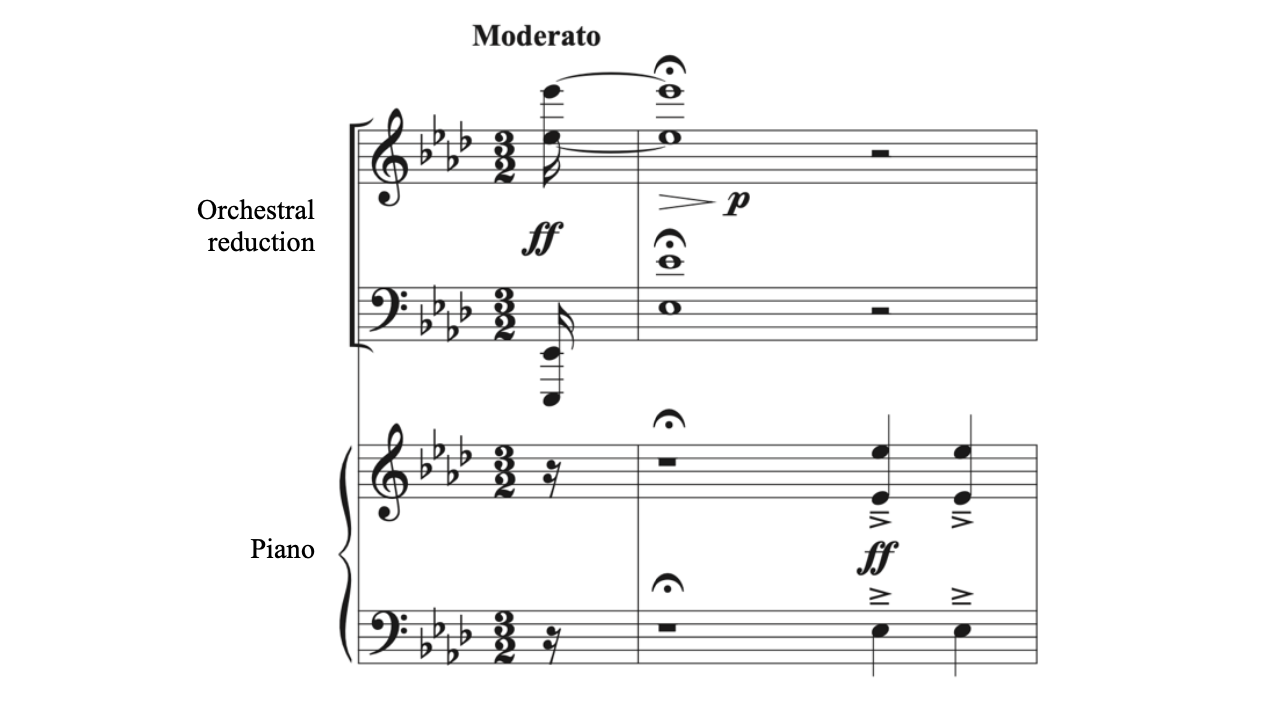
The final is E-flat, yet the key signature has four flats instead of three as it would with E-flat major. The Mixolydian mode is like major but something is lowered, thus resulting in one more flat in the key signature.
Identifying Key Signatures Based on Major or Minor
- Identify if the key signature is closer to major (mi-mode) or minor (me-mode).
- Identify is something is raised or lowered compared to the major or minor key signature to figure out the mode.
- If something is raised (i.e., if the key signature has an additional sharp or a missing flat), then the mode is either Lydian or Dorian.
- If something is lowered (i.e., if the key signature has an additional flat or a missing sharp), then then mode is either Mixolydian or Phrygian.
Recall that in major and minor, some key signatures did not exist (e.g., G-sharp major or G-flat minor). However, because various notes are lowered or raised for modes, some mi-modes exist that do not exist in major, and some me-modes exist that do not exist in minor.
For example, let’s write the key signature for G-sharp Mixolydian. Starting from G-sharp major is not an option since G-sharp major does not exist. Instead, we can start from the all-white-key mode.
Example 11.4.8. Writing the key signature for G-sharp Mixolydian

- Example 11.4.8A: This is the key signature for G Mixolydian.
- G Mixolydian is like G major, but something is lowered. This removes the one sharp from G major.
- Alternatively, you can remember that G Mixolydian is an all-white-key mode.
- Example 11.4.8B: Since G Mixolydian has no sharps, G-sharp Mixolydian has all seven sharps.
We can apply this same technique to other modes that do not have a major or minor key, such as F-flat Lydian, D-flat Dorian, and E-sharp Phrygian. Notice that like G Mixolydian, these finals and modes are also based on all-white key modes.
Example 11.4.9. Key signatures for modes without major or minor keys

- Example 11.4.9A:
- A1: The all-white-key mode on F is Lydian.
- A2: Therefore, F-flat Lydian has all seven flats.
- Example 11.4.9B:
- B1: The all-white-key mode on D is Dorian.
- B2: Therefore, D-flat Dorian has all seven flats.
- Example 11.4.9C:
- C1: The all-white-key mode on E is Phrygian.
- C2: Therefore, E-sharp Phrygian has all seven sharps.
Recall that there is only one major mode and one minor mode that has all seven sharps (C-sharp major and A-sharp minor) and there is only one major mode and one minor mode that has all seven flats (C-flat major and A-flat minor). Similarly, there is only one mi-mode and one me-mode that has all seven sharps (G-sharp Mixolydian and E-sharp Phrygian) and one mi-mode and one me-mode that has all seven flats (F-flat Lydian and D-flat Dorian).
There are also modes that do not exist whereas their major or minor modes do exist. These include A-flat Phrygian, A-sharp Dorian, C-flat Mixolydian, and C-sharp Lydian. We can examine A-flat Phrygian.
Example 11.4.10. Key signature for A-flat Phrygian
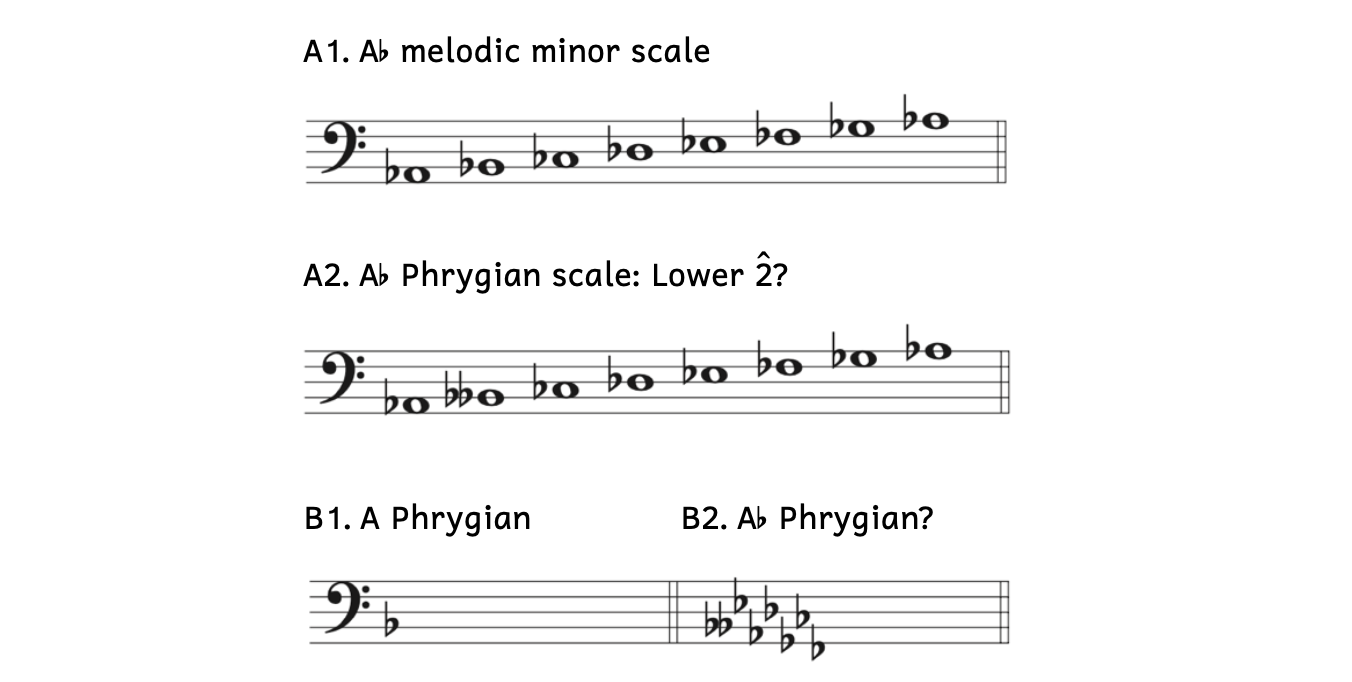
We can attempt to find the key signature of A-flat Phrygian using two different methods:
- Method one: Starting from the melodic minor scale
- Example 11.4.10A1: The A-flat melodic minor scale has seven flats.
- Example 11.4.10A2: The Phrygian scale lowers [latex]\hat2[/latex], but that would result in a B-double flat.
- Method two: Starting from the key signature of A Phrygian
- Example 11.4.10B1: The key signature for A Phrygian has one flat.
- Example 11.4.10B2: For A-flat Phrygian, you would need to add seven flats, resulting in B-double flat. Clearly, there is no such key signature as this.
When writing and identifying key signatures, be aware that some modes exist that did not exist in major or minor. On the other hand, not every mode exists that existed as a major or minor key.
Practice 11.4A
Directions:
- Using the method with mi-modes and me-modes, write the key signatures for the following modes.

Click here to watch the tutorial.
Practice 11.4B
Directions:
- Answer the following questions based on major or minor key signatures.
- If the final is D and the key signature has three sharps, what is the mode?
- If the final is F and the key signature has three flats, what is the mode?
- If the final is E-flat and the key signature has four flats, what is the mode?
- If the final is A and the key signature has one flat, what is the mode?
- If the final is B-flat and the key signature has one flat, what is the mode?
Click here to watch the tutorial.
Solution
11.5 KEY SIGNATURES BASED ON ALL-WHITE-KEY MODES
For modes, many students find the all-white-key modes method for key signatures to be faster and easier. Follow these steps when identifying key signatures based on the all-white-key modes:
- Identify the major key based on the given key signature.
- Based on the major key, identify the scale degree of the given final.
- Associate the modes and their all-white-key scales with scale degree numbers.
- [latex]\hat1[/latex]: Ionian
- [latex]\hat2[/latex]: Dorian
- [latex]\hat3[/latex]: Phrygian
- [latex]\hat4[/latex]: Lydian
- [latex]\hat5[/latex]: Mixolydian
- [latex]\hat6[/latex]: Aeolian
- [latex]\hat7[/latex]: Locrian
When using this method, never base anything from the minor key. We will do some samples together.
Example 11.5.1. Identifying modes with the all-white-key modes method

- Example 11.5.1A:
- The major key with four flats is A-flat major.
- In the key of A-flat major, C is [latex]\hat3[/latex].
- [latex]\hat3[/latex] is associated with Phrygian; therefore, the key is C Phrygian.
- Example 11.5.1B:
- The major key with two sharps is D major.
- In the key of D major, E is [latex]\hat2[/latex].
- [latex]\hat2[/latex] is associated with Dorian; therefore, the key is E Dorian.
- Example 11.5.1C:
- The major key with five sharps is B major.
- In the key of B major, F-sharp is [latex]\hat5[/latex].
- [latex]\hat5[/latex] is associated with Mixolydian; therefore, the key is F-sharp Mixolydian.
- Example 11.5.1D:
- The major key with four flats is A-flat major.
- In the key of A-flat major, D-flat is [latex]\hat4[/latex].
- [latex]\hat4[/latex] is associated with Lydian; therefore, the key is D-flat Lydian.
The answers to Example 11.5.1 are shown in Example 11.5.2.
Example 11.5.2. Answers to Example 11.5.1

The keys in Example 11.5.2 were the same as the ones in Example 11.4.6. Which technique did you prefer?
Using the All-White-Key Modes to Identify Key Signatures
- Identify the major key based on the given key signature.
- Based on the major key, identify the scale degree of the given final.
- Associate the modes and their all-white-key scales with scale degree numbers.
- [latex]\hat1[/latex]: Ionian
- [latex]\hat2[/latex]: Dorian
- [latex]\hat3[/latex]: Phrygian
- [latex]\hat4[/latex]: Lydian
- [latex]\hat5[/latex]: Mixolydian
- [latex]\hat6[/latex]: Aeolian
- [latex]\hat7[/latex]: Locrian
When writing key signatures using this method, use a similar process.
-
-
- Associate the modes and their all-white-key scales with scale degree numbers.
- Identify in which major key the given final is the associated scale degree number.
- The key signature for the mode will be the same as the major key.
-
Example 11.5.3. Writing modes with the all-white-key modes method.

-
-
- Example 11.5.3A:
- Lydian is associated with [latex]\hat4[/latex].
- A-flat is [latex]\hat4[/latex] in the key of E-flat major.
- Therefore, A-flat Lydian has three flats (because E-flat major has three flats).
- Example 11.5.3B:
- Phrygian is associated with [latex]\hat3[/latex].
- B-flat is [latex]\hat3[/latex] in the key of G-flat major.
- Therefore, B-flat Phrygian has six flats (because G-flat major has six flats).
- Example 11.5.3C: A Mixolydian
- Mixolydian is associated with [latex]\hat5[/latex].
- A is [latex]\hat5[/latex] in the key of D major.
- Therefore, A Mixolydian has two sharps (because D major has two sharps).
- Example 11.5.3D: D-sharp Dorian
- Dorian is associated with [latex]\hat2[/latex].
- D-sharp is [latex]\hat2[/latex] in the key of C-sharp major.
- Therefore, D-sharp Dorian has seven sharps (because C-sharp major has seven sharps).
- Example 11.5.3A:
-
The answers to Example 11.5.3 are shown in Example 11.5.4.
Example 11.5.4. Answers to Example 11.5.3.

Although the all-white-key method may seem easier and faster, it unfortunately does not help with aural identification (which is covered in a later section). As with most procedures that have more than one method, it is best to know how to do all the methods so that you can choose which is better for a specific question and you can have a different system to check your work.
Using the All-White-Key Modes to Write Key Signatures
- Associate the modes and their all-white-key scales with scale degree numbers.
- Identify in which major key the final is that specific scale degree number.
- The key signature for the mode will be the same as the major key.
Recall that we learned about some modes that existed that did not exist in major or minor, as well as some modes that did not exist but that did exist in major or minor. Let’s apply the all-white-key mode method to these modes.
The four modes that existed but did not exist in major or minor included G-sharp Mixolydian, F-flat Lydian, D-flat Dorian, and E-sharp Phrygian. We will go through two of them step-by-step using the all-white-key mode method.
-
-
- G-sharp Mixolydian
- Mixolydian = [latex]\hat5[/latex]
- G-sharp is [latex]\hat5[/latex] in the key of C-sharp major (seven sharps).
- Therefore, G-sharp Mixolydian has seven sharps.
- D-flat Dorian
- Dorian = [latex]\hat2[/latex]
- D-flat is [latex]\hat2[/latex] in the key of C-flat major (seven flats).
- Therefore, D-flat Dorian has seven flats.
- G-sharp Mixolydian
-
Using the all-white-key mode method for these modes is simple. Recall that there are four keys that existed in major or minor, but not as modes: A-flat Phrygian, A-sharp Dorian, C-flat Mixolydian, and C-sharp Lydian. We will see how A-flat Phrygian does not exist using the all-white-key modes method.
-
-
- A-flat Phrygian
- Phrygian = [latex]\hat3[/latex]
- A-flat is [latex]\hat7[/latex] in the key of F-flat major? F-flat major does not exist.
- Therefore, A-flat Phrygian does not exist.
- A-flat Phrygian
-
The All-White-Key Modes Method
The all-white-key mode method can be extremely quick. Do not forget that you only associate scale degree numbers with major keys and not minor keys. Although you can retrieve answers quickly with the all-white-key mode method, be aware that it is not helpful for aural identification.
Practice 11.5A
Directions:
- Using the all-white-key method, write the key signatures for the following modes.

Click here to watch the tutorial.
Practice 11.5B
Directions:
- Answer the following questions using the all-white-key modes method.
- If the final is G-sharp and the key signature has four sharps, what is the mode?
- If the final is E and the key signature has five sharps, what is the mode?
- If the final is C-flat and the key signature has seven flats, what is the mode?
- If the final is D-sharp and the key signature has seven sharps, what is the mode?
- If the final is A-flat and the key signature has five flats, what is the mode?
Click here to watch the tutorial.
Solution
Practice 11.5C
Directions:
- Using either method, write the key signature for the following modes.
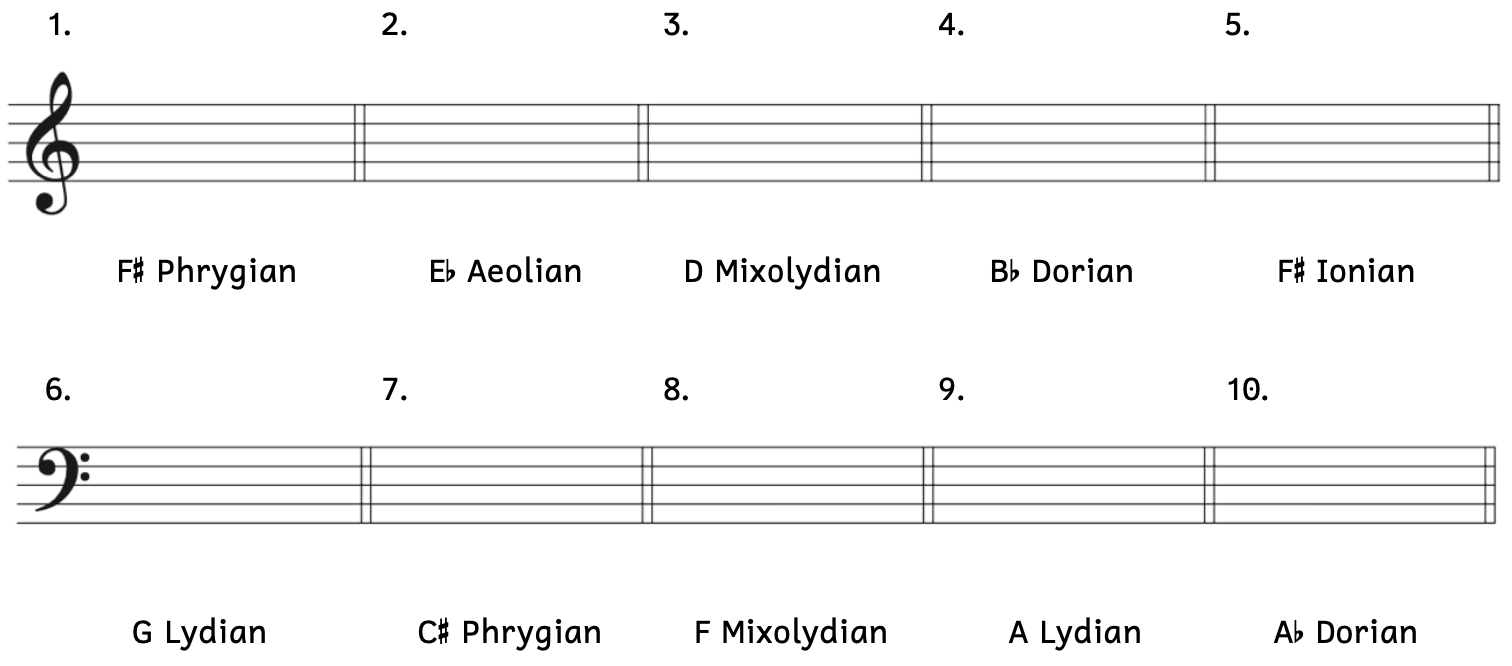
Click here to watch the tutorial.
Practice 11.5D
Directions:
- Answer the following questions using either method.
- If the final is C-sharp and the key signature has six sharps, what is the mode?
- If the final is F-sharp and the key signature has seven sharps, what is the mode?
- If the final is B and the key signature has one sharp, what is the mode?
- If the final is D-sharp and the key signature has six sharps, what is the mode?
- If the final is A and the key signature has one flat, what is the mode?
- If the final is G-flat and the key signature has six flats, what is the mode?
- If the final is A and the key signature has one sharp, what is the mode?
- If the final is E-flat and the key signature has four flats, what is the mode?
- If the final is B and the key signature has six sharps, what is the mode?
- If the final is F and the key signature has five flats, what is the mode?
Click here to watch the tutorial.
Solution
11.6 ANALYZING MODES
Just as there were two methods for identifying and writing key signatures for modes, there are also two ways to analyze the mode an example is in.
When identifying the mode of an example based on major or minor key signatures, follow these steps:
-
-
- Identify the final. The most reliable way to identify the final is by looking at the last note.
- From the final, identify [latex]\hat3[/latex]: Is it a mi-mode or me-mode?
- How does it differ from a major key or minor key?
- Just like major: Ionian
- Like major, but one more sharp/one fewer flat: Lydian
- Like major, but one more flat/one fewer sharp: Mixolydian
- Just like minor: Aeolian
- Like minor, but one more sharp/one fewer flat: Dorian
- Like minor, but one more flat/one fewer sharp: Phrygian
- Like minor, but two more flats/two fewer sharps: Locrian
- Just like major: Ionian
-
When identifying the mode of an example based on the all-white-key mode method, follow these steps:
-
-
- Identify the major key of the key signature.
- For that major key signature, determine what scale degree number the final is.
- Associate the scale degree number with the all-white-key mode.
- [latex]\hat1[/latex]: Ionian
- [latex]\hat2[/latex]: Dorian
- [latex]\hat3[/latex]: Phrygian
- [latex]\hat4[/latex]: Lydian
- [latex]\hat5[/latex]: Mixolydian
- [latex]\hat6[/latex]: Aeolian
- [latex]\hat7[/latex]: Locrian
-
Let’s apply both these methods to analyze four short melodies.
Example 11.6.1. Analysis #1

Based on major or minor key signatures
-
-
- Final = G
- The third above G is major (B); therefore, this is a mi-mode.
- How is it different from the key of G major? The key signature has one more sharp than G major. Therefore, this is in G Lydian.
-
Based on all-white-key modes
-
-
- The major key signature with two sharps in D major.
- In D major, the final (G) is [latex]\hat4[/latex].
- [latex]\hat4[/latex] is associated with Lydian. Therefore, this is in G Lydian.
-
Do not rely entirely on the key signature. Just as with tonal music, sometimes accidentals in the musical example are written in (rather than included in the key signature).
Example 11.6.2. Analysis #2

In Example 11.6.2, the key signature appears to have only one flat. However, every appearance of E is E-flat. For this reason, we interpret the key signature as having two flats, and not only one.
Based on major or minor key signatures
-
-
- Final = D
- The third above D is minor (F); therefore, this is a me-mode.
- How is it different from the key signature of D minor? Having two flats, something is lowered compared to D minor. Therefore, this is in D Phrygian.
-
Based on all-white-key modes
-
-
- The major key signature with two flats is B-flat major.
- In B-flat major, the final (D) is [latex]\hat3[/latex].
- [latex]\hat3[/latex] is associated with Phrygian. Therefore, this is in D Phrygian.
-
Example 11.6.3. Analysis #3

In Example 11.6.3, the first note is F while the last note is B-flat. The last note is more reliable for the final, so always use the last note.
Based on major or minor key signatures
-
-
- Final = B-flat
- The third above B-flat is minor (D-flat); therefore, this is a me-mode.
- How is it different from the B-flat minor scale? The key signature has one fewer flat than B-flat minor. Therefore, this is in B-flat Dorian.
-
Based on all-white-key modes
-
-
- The major key signature with four flats is A-flat major.
- In A-flat major, the final (B-flat) is [latex]\hat2[/latex].
- [latex]\hat2[/latex] is associated with Dorian. Therefore, this is in B-flat Dorian.
-
Example 11.6.4. Analysis #4

Based on major or minor key signatures
-
-
- Final = F-sharp
- The third above F-sharp is minor (A); therefore, this is a me-mode.
- How is it different from the key signature of F-sharp minor? There are two differences. F-sharp minor has three sharps and this key signature has only one sharp. Because two notes are lowered, this is in F-sharp Locrian.
-
Based on all-white-key modes
-
-
- The major key signature with one sharp is G major.
- In G major, the final (F-sharp) is [latex]\hat7[/latex].
- [latex]\hat7[/latex] is associated with Locrian. Therefore, this is in F-sharp Locrian.
-
Composers can make a smooth transition from a major or minor key to a mi-mode or me-mode. Try to analyze both the key and mode used in Example 11.6.5.
Example 11.6.5. Beethoven[10], Missa Solemnis, Credo
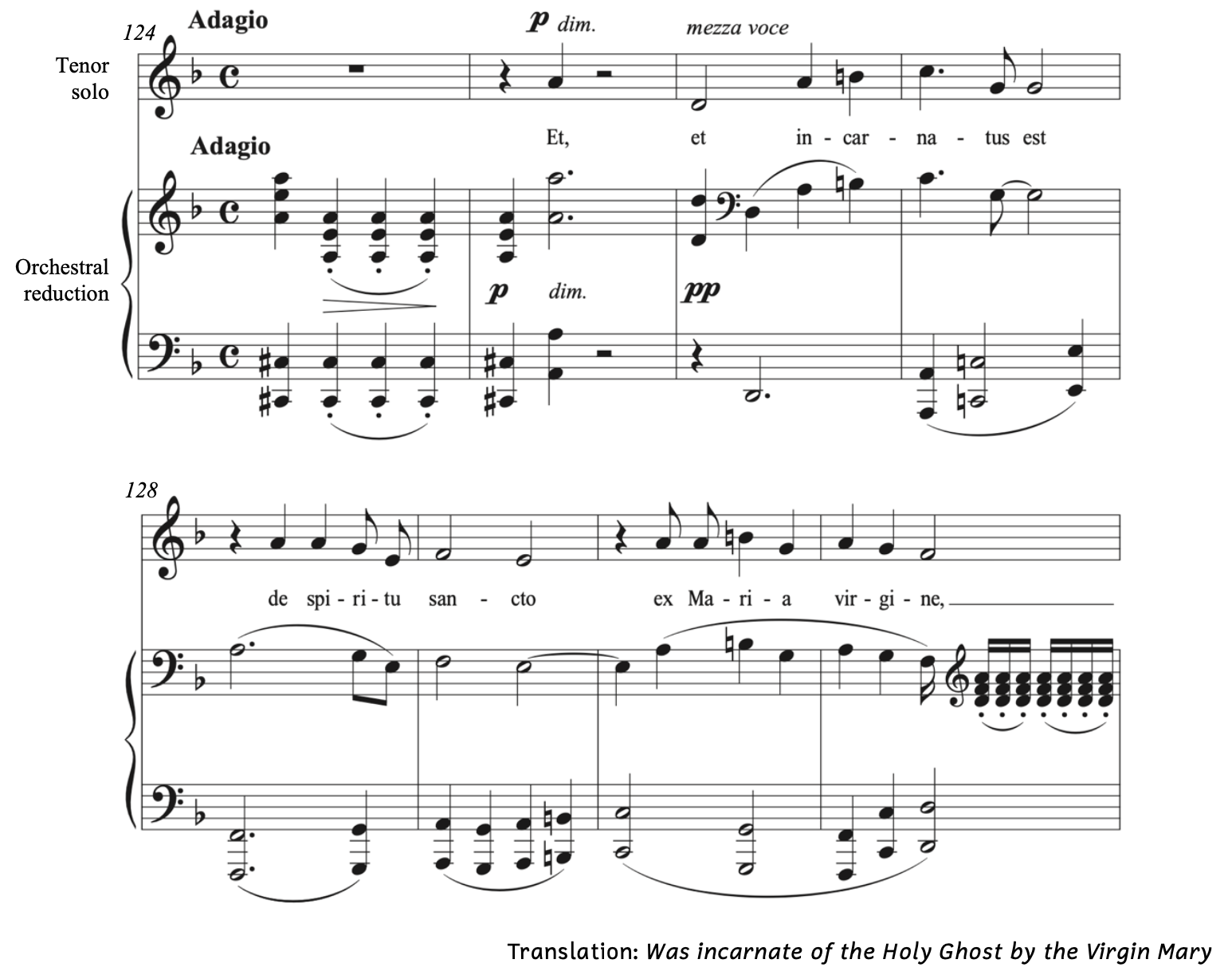
-
-
- The Adagio section of the Credo opens in D minor. The key signature of one flat and the raised leading tone of C-sharp confirm this key.
- When the tenor begins to sing, not only is the B-flat raised to B-natural, but the aforementioned C-sharp is no longer raised.
- For the rest of the example, the collection of pitches shows that it is in the mode of D Dorian. Not only is [latex]\hat6[/latex] (B-flat) raised each time, but the subtonic (C-natural) is exclusively used instead of the raised leading tone.
-
Analyzing Modes
- Method #1: Based on major or minor key signatures
- Identify the final.
- From the final, identify [latex]\hat3[/latex]: is it a mi-mode or me-mode?
- How does it differ from the major key or minor key with the same tonic/final? The mode is based on the specific type of alteration.
- Method #2: Based on all-white-key modes
- Identify the major key of the key signature.
- For that major key signature, determine what scale degree number the final is.
- Associate the scale degree number with the all-white-key mode.
Practice 11.6
Directions:
- Identify the final and mode of the following examples (e.g., C-sharp Phrygian).[11]. For samples, see Examples 11.6.1-11.6.4.
1. ______________________________________

2. ______________________________________

3. ______________________________________

4. ______________________________________

5. ______________________________________

6. ______________________________________

7. ______________________________________

8. ______________________________________

9. ______________________________________

10. ______________________________________

Click here to watch the tutorial.
Solution
11.7 AURAL IDENTIFICATION
Since modes are often not covered very thoroughly in theory textbooks, this textbook includes a small section to help you identify modes aurally. For identifying modes, using mi-modes and me-modes is often the easiest way. Using the all-white-key modes methods only works on paper, not for listening. You can use this aural identification flow chart (Example 11.7.1).
Example 11.7.1. Diatonic modes aural identification flow chart
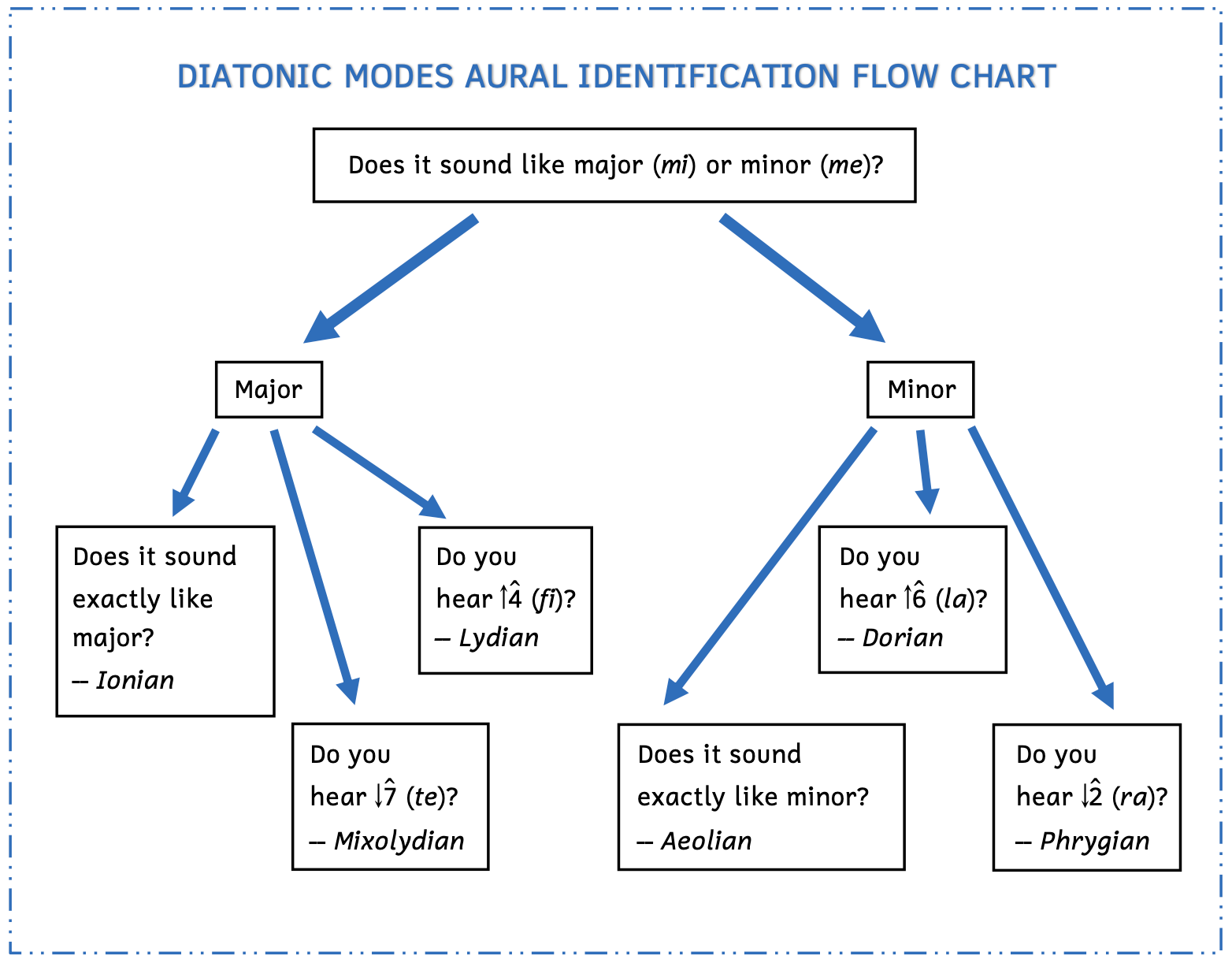
You do not have to hear which specific scale degrees are raised or lowered. Rather, try to hear if something is raised or lowered. The practice exercises in this section will help you identify both scales and melodies that are based on modes.
Practice 11.7A
Directions:
- Listen to the following scales and write the mode.
1. ______________________________________
2. ______________________________________
3. ______________________________________
4. ______________________________________
5. ______________________________________
6. ______________________________________
7. ______________________________________
8. ______________________________________
9. ______________________________________
10. ______________________________________
Click here to watch the tutorial.
Solution
Practice 11.7B
Directions:
- Listen to the following melodies and write the mode.[12]
1. ______________________________________
2. ______________________________________
3. ______________________________________
4. ______________________________________
5. ______________________________________
6. ______________________________________
7. ______________________________________
8. ______________________________________
9. ______________________________________
10. ______________________________________
Click here to watch the tutorial.
Solution
11.8 PENTATONIC MODES
“Pentatonic” literally means “five tones,” and refers to music based on five pitches. People from all over the world have been making music from different pentatonic collections for thousands of years. In fact, bone flutes were recently discovered that were tuned to a pentatonic scale; these flutes are dated from approximately 50,000 years ago! Check out Bobby McFerrin’s interactive talk about the pentatonic mode below:
There are a number of different types of pentatonic collections. However, we will only focus on two types: the major pentatonic collection and the minor pentatonic collection.
The major pentatonic collection is so named because it is just like the major scale, but with the tritone removed, resulting in only five different pitches. In major, the tritone is made of [latex]\hat4[/latex] and [latex]\hat7[/latex]. The pentatonic scale appears to have six pitches since you need to rewrite the starting pitch, but only contains five different pitches (Example 11.8.1).
Example 11.8.1. Major scale versus major pentatonic scale

- Example 11.8.1A shows the C major scale.
- Example 11.8.1B shows the C major pentatonic scale.
- The notes that made up the tritone in the C major scale—F ([latex]\hat4[/latex]) and B ([latex]\hat7[/latex])—have been removed to create the major pentatonic scale.
Many American folk tunes (and pop tunes) are based on this major pentatonic collection. Look at the familiar song “Amazing Grace” (Example 11.8.2).
Example 11.8.2. “Amazing Grace”
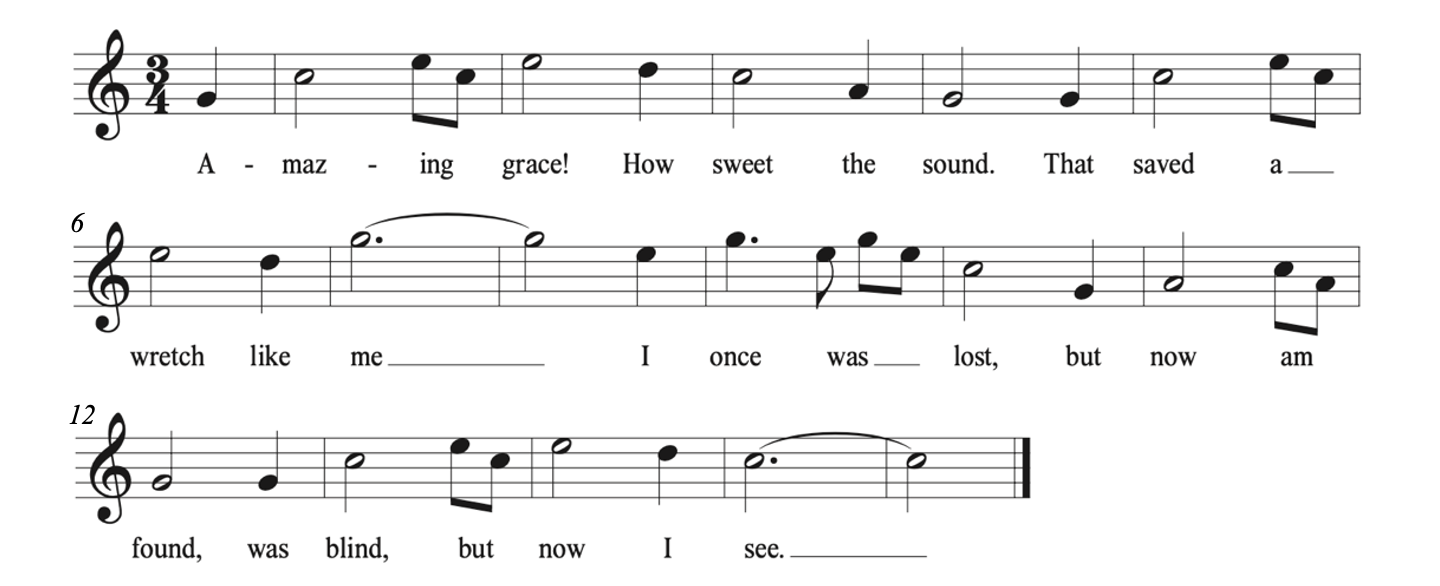
- Notice that only five different notes are used: C, D, E, G, and A. This makes the melody pentatonic.
- C is the center of the song, and the pitches F ([latex]\hat4[/latex]) and B ([latex]\hat7[/latex]) are missing. This makes the melody major pentatonic.
The minor pentatonic collection is so named because it is just like the natural minor scale, but with the tritone removed, results in five different pitches. In the natural minor scale, the tritone is made of [latex]\hat2[/latex] and [latex]\hat6[/latex].

- Example 11.8.3A shows the C natural minor scale.
- Example 11.8.3B shows the C minor pentatonic scale.
- The notes that made up the tritone in the C natural minor scale—D ([latex]\hat2[/latex]) and A-flat ([latex]\hat6[/latex])—have been removed to create the minor pentatonic scale.
One example that uses the minor pentatonic is the traditional song “Wayfaring Stranger” (Example 11.8.4).
Example 11.8.4. “Wayfaring Stranger”

- Notice that only five different notes are used: C, E-flat, F, G, and B-flat. This makes the melody pentatonic.
- C is the center of the song, and the pitches D ([latex]\hat2[/latex]) and A-flat ([latex]\hat6[/latex]) are missing. This makes the melody minor pentatonic.
The minor pentatonic collection is not as common as the major pentatonic collection, but it is closely linked to the blues scale. The blues scale is just like the minor pentatonic scale, with the addition of raised [latex]\hat4[/latex].
Example 11.8.5. Blues scale

-
-
- Example 11.8.5A shows the C minor pentatonic scale.
- Example 11.8.5B shows the C blues scale.
- The pitch F-sharp (raised [latex]\hat4[/latex]) has been added to create the blues scale.
-
The blues scale contains a versatile collection that is often used to improvise.
Most of the music we will be analyzing in this book will be in major or minor keys. When you do discover that a piece is in a mode, be sure to differentiate between a diatonic mode and a pentatonic mode. What is the mode used in Example 11.8.6?
Example 11.8.6. Identifying the mode: Bartók, Mikrokosmos No. 78

-
-
- The final is E and the key signature tells us Example 11.8.6 is in E Phrygian.
- However, the characteristic lowered [latex]\hat2[/latex] (F-natural) is missing. Upon closer inspection, [latex]\hat6[/latex] (C) is also missing.
- Indeed, Bartók only uses five notes in the start of this piece, resulting in a pentatonic opening. Because [latex]\hat2[/latex] and [latex]\hat6[/latex] are missing, this mode is minor pentatonic.
-
The title of Example 11.8.6 is “Five-Tone Scale.” The title was not added for obvious reasons. When analyzing modes, you cannot assume it is a diatonic mode or a pentatonic mode.
Pentatonic Collections
- Number of different pitches: 5.
- The major pentatonic collection contains the same notes as the major scale, but without the tritone ([latex]\hat4[/latex] and [latex]\hat7[/latex]).
- The minor pentatonic collection contains the same notes as the natural minor scale, but without the tritone ([latex]\hat2[/latex] and [latex]\hat6[/latex]).
Practice 11.8A
Directions:
- Write the following ascending scales using whole notes. Do not add a key signature.
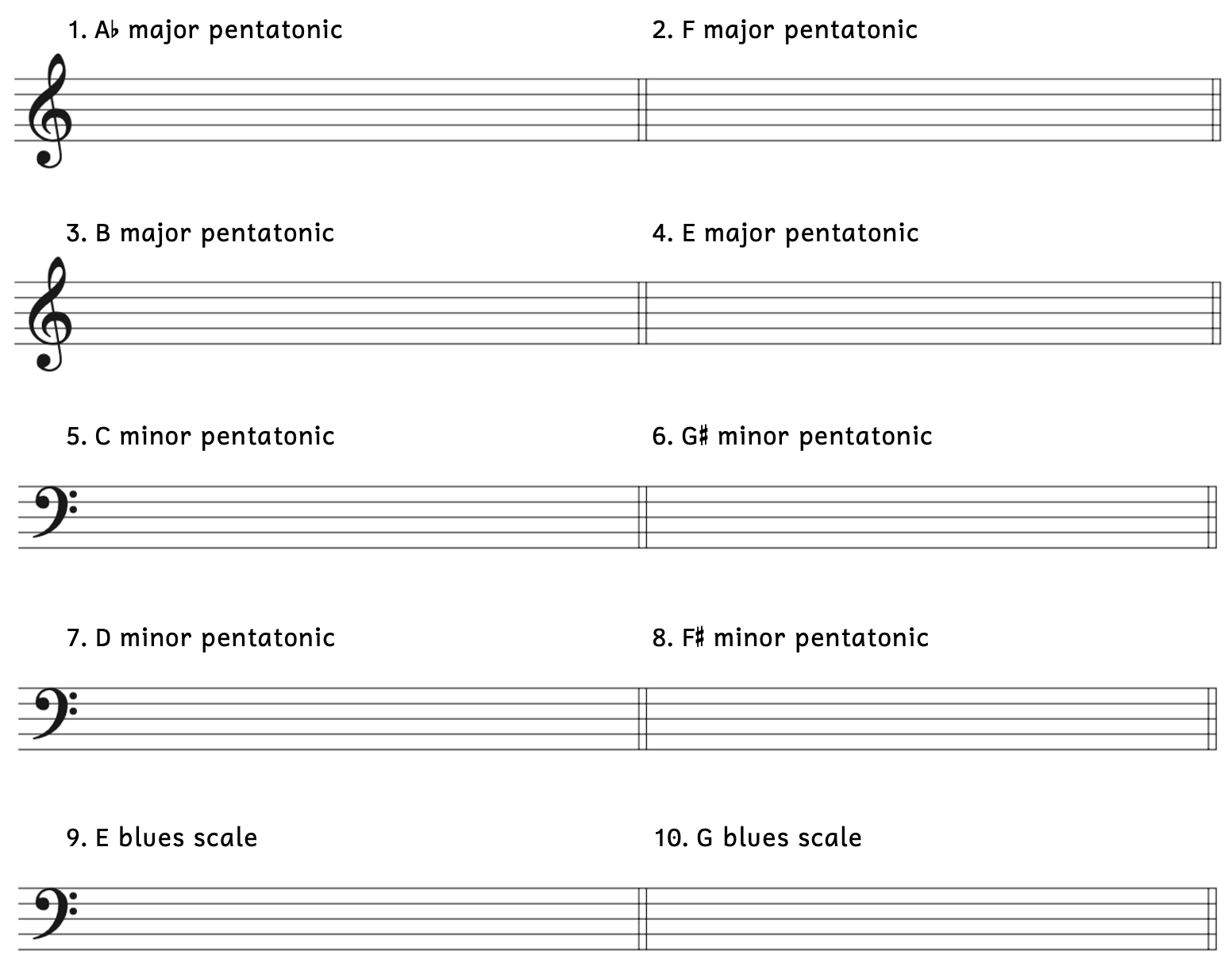
Practice 11.8B
Directions:
- Identify the mode as major pentatonic, minor pentatonic, or neither.
1. ______________________________________ “Shortnin’ Bread”[13]
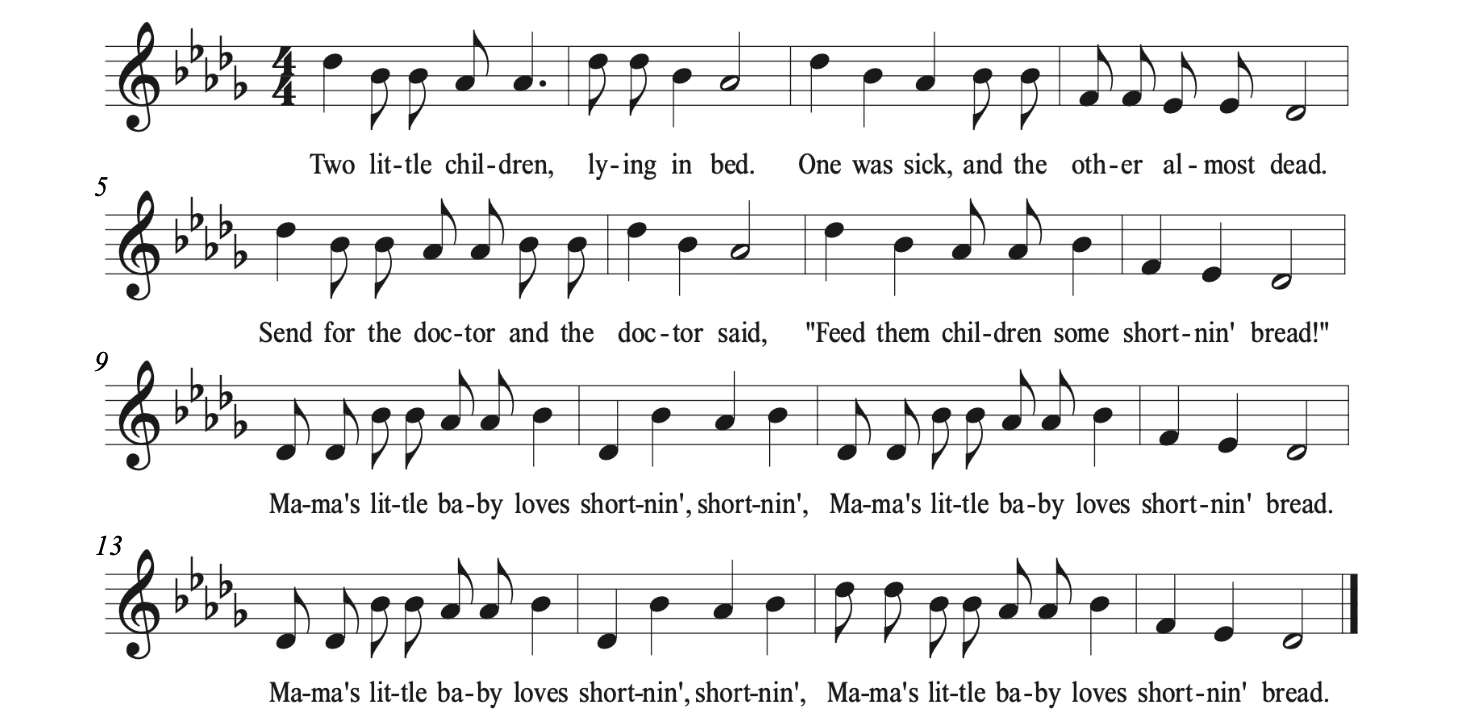
2. ______________________________________ “Hevenu Shalom A’leychem“[14]

3. ______________________________________ “Arirang“[15]

4. ______________________________________ “Turn Me ‘Round”[16]
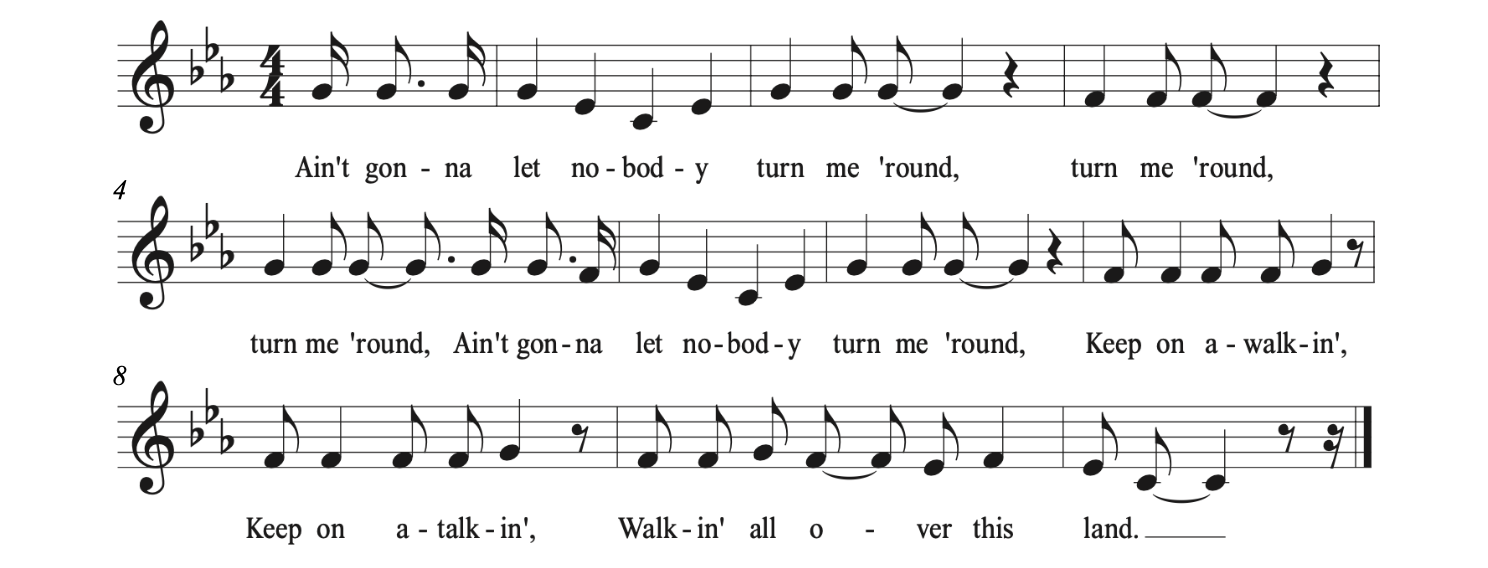
5. ______________________________________ “Golden Ring Around the Susan Girl”[17]

Click here to watch the tutorial.
Solution
11.9 ANALYSIS: BRAHMS, SYMPHONY NO. 4
In Chapter 9, we saw how Brahms utilized thirds in the first movement of his Fourth Symphony in E Minor and how the thirds return in the fourth movement. The second movement begins in a mode rather than a key.
Example 11.9.1. Brahms[18], Symphony No. 4, ii – Andante Moderato
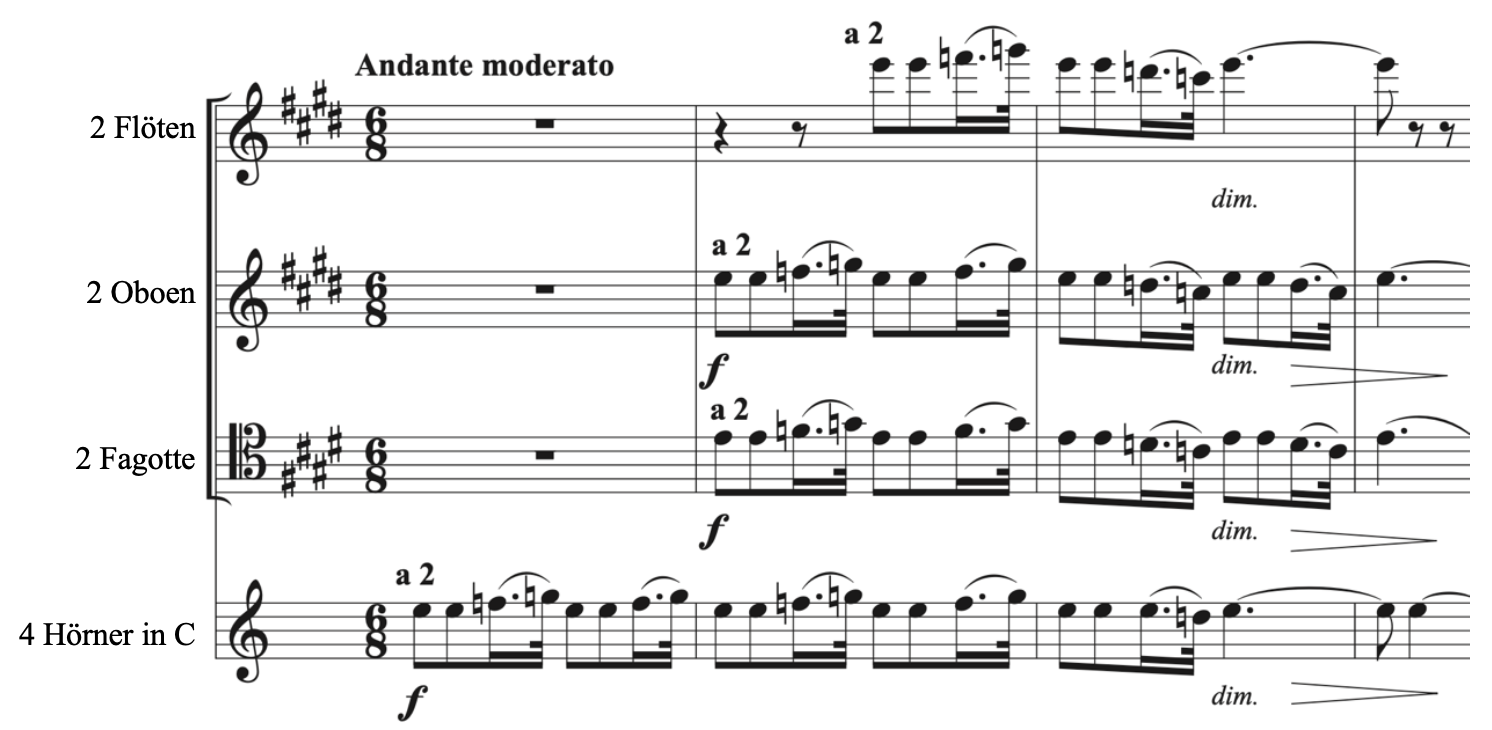
-
-
- The key signature and the instruments’s opening pitches imply the key of E major.
- However, we soon see that me is used instead of mi—is it in E minor?
- It is not in E minor because E minor would require an F-sharp and we only see F-natural.
- This movement is in E Phrygian because it is like E minor, but [latex]\hat2[/latex] (F-sharp) has been lowered (F-natural).
- After this opening, the sharps that belong to the key of E major finally appear.
-
Just as Brahms used thirds to connect movements, he uses E Phrygian to play a role within the entire symphony. Observe the keys in the four movements:
-
-
- Movement I: E minor
- Movement II: E major (but begins in E Phrygian)
- Movement III: C major
- Movement IV: E minor
-
Notice that the tonic (E) ties three of the movements together. At first glance, C major seems out of place. However, the link between C major and the other movements is that E Phrygian’s key signature is the same as that of C major: no sharps or flats.
In addition, Brahms brings C back in the final movement in E minor (Example 11.9.2).
Example 11.9.2. Brahms, Symphony No. 4, iv – Allegro energico e passionato
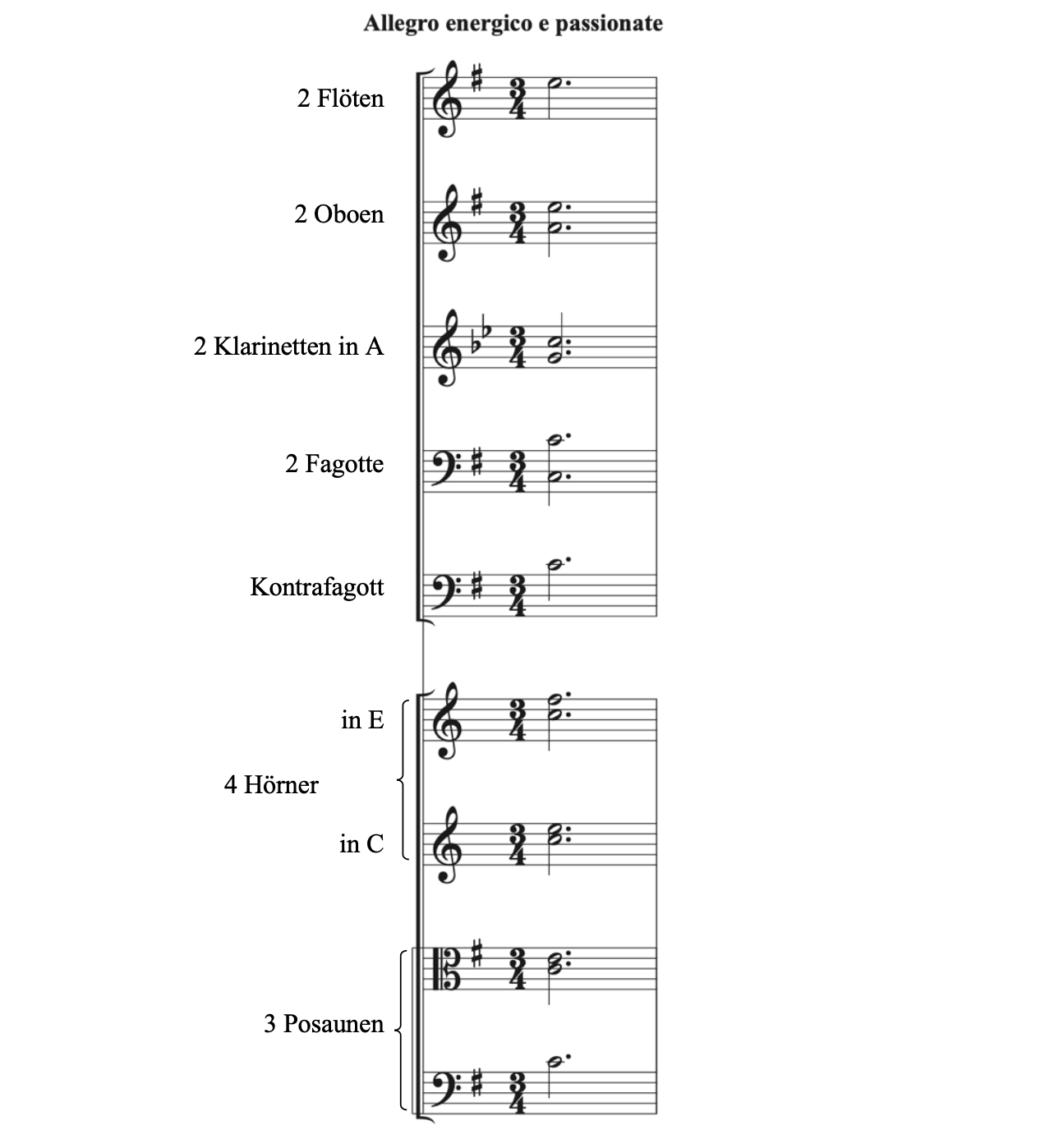
The key signature and E’s in the highest instruments (flutes and oboes) tells us that the fourth movement begins in E minor. However, look at the lowest note: The trombones and contrabassoon (which sound an octave lower) have C’s. Through descending thirds, keys, and modes, Brahms connects E and C through the four movements of this symphony. Moreover, a descending third from E is C.
SUMMARY
-
-
- A mode refers to the collection of pitches in a piece of music. We have already learned about two modes: the major mode and the minor mode. However, diatonic modes (or church modes) are even older. They are called diatonic modes because they use every note name once (and only once). [11.1]
- There are seven diatonic modes, which you can visualize with white keys on the piano: [11.1]
- C to C: Ionian
- D to D: Dorian
- E to E: Phrygian
- F to F: Lydian
- G to G: Mixolydian
- A to A: Aeolian
- B to B: Locrian
- Unlike major and minor modes, diatonic modes lack the tendency tones of tonality; in fact, [latex]\hat1[/latex] is not called the tonic in diatonic modes, but rather, the final. [11.1]
- One way to quickly identify and write modes is by looking at their third: [11.2] [11.3]
- If [latex]\hat3[/latex] is a major third, it is a mi-mode.
- If lowered [latex]\hat3[/latex] is a minor third, it is a me-mode.
- There are three mi-modes. They are like the major collection, but with these alterations: [11.2]
- Ionian: same as major
- Lydian: major with raised [latex]\hat4[/latex]
- Mixolydian: major with lowered [latex]\hat7[/latex]
- There are four me-modes. They are like the natural minor collection, but with these alterations: [11.3]
- Aeolian: same as natural minor
- Dorian: natural minor with raised [latex]\hat6[/latex]
- Phrygian: natural minor with lowered [latex]\hat2[/latex]
- Locrian: natural minor with lowered [latex]\hat2[/latex] and lowered [latex]\hat5[/latex]
- When identifying or writing key signatures, you can either begin with major or minor keys, or use the all-white-key mode method. [11.4] [11.5]
- When analyzing modes, you can either use the mi-mode/me-mode method, or the all-white-key mode method. [11.6]
- When aurally identifying modes, use the mi-mode/me-mode method. [11.7]
- Pentatonic modes are made of five pitches. Although there are many different types, this book only covers two: [11.8]
- Major pentatonic: major scale without the tritone ([latex]\hat4[/latex] and [latex]\hat7[/latex])
- Minor pentatonic: natural minor scale without the tritone ([latex]\hat2[/latex] and [latex]\hat6[/latex])
- The blues scale is like the minor pentatonic but with raised [latex]\hat4[/latex]. [11.8]
- In his Fourth Symphony, Brahms begins the second movement in the Phrygian mode. [11.9]
-
TERMS
- Guillaume Du Fay (1397-1474) was a Franco-Flemish composer. This score was edited by Alejandro Enrique Planchart. ↵
- This example was written by Kevin L. López (1996-), who is a Cuban-American composer. ↵
- Béla Bartók (1881-1945) was a Hungarian composer and ethnomusicologist. ↵
- These exercises were written by Jonathon Garcia (1995-), who is an American composer and percussionist. ↵
- Giovanni Pierluigi da Palestrina (c. 1525-1594) was an Italian composer. ↵
- Claude Debussy (1862-1918) was a French composer. ↵
- If you are curious about the Locrian key signature, it has the same key signature as minor, but with two lowered accidentals. ↵
- Although we do not cover Locrian key signatures, it is used here to complete the scale. ↵
- Ottorino Respighi (1879-1936) was an Italian composer. ↵
- Ludwig van Beethoven (1770-1827) was a German composer. ↵
- These exercises were written by Jonathon Garcia. ↵
- The melodies for #4-#10 were written by Jonathon Garcia. ↵
- "Shortnin' Bread" is an African-American folk song (1890s). ↵
- "Hevenu Shalom A'leychem" is an Israeli song. ↵
- "Arirang" is a traditional Korean folk song. ↵
- "Turn Me 'Round" is an African American spiritual. ↵
- "Golden Ring Around the Susan Girl" is an Appalachian folk song. ↵
- Johannes Brahms (1833-1897) was a German composer. ↵
Tells us the collection of pitches used based on a center pitch. The major mode and minor mode are the most common modes.
Modes also known as church modes that are even older than the major mode and minor mode. They include the Ionian, Dorian, Phrygian, Lydian, Mixolydian, Aeolian, and Locrian.
Modes also known as diatonic modes that are even older than the major mode and minor mode. They include the Ionian, Dorian, Phrygian, Lydian, Mixolydian, Aeolian, and Locrian.
All-white-key mode from C to C. Like the major scale.
All-white-key mode from D to D. Like the minor scale, but scale degree 6 is raised.
All-white-key mode from E to E. Like the minor scale, but scale degree 2 is lowered.
All-white-key mode from F to F. Like the major scale, but scale degree 4 is raised.
All-white-key mode from G to G. Like the major scale, but scale degree 7 is lowered.
All-white-key mode from A to A. Like the natural minor scale.
All-white-key mode from B to B. Like the natural minor scale, but scale degrees 2 and 5 are lowered.
Scale degree 1 of a diatonic mode or pentatonic mode.
Modes in which the third is major. They include the Ionian, Lydian, and Mixolydian modes.
Modes in which the third is a minor third. They include the Aeolian, Dorian, Phrygian, and Locrian modes.
Mode with five notes; in this textbook, we distinguish between major pentatonic and minor pentatonic although there are many more
Mode with only five notes from the major scale, omitting scale degrees 4 and 7.
Mode of five pitches based on the natural minor scale, but omitting scale degrees 2 and 6.
Scale based on the minor pentatonic scale with the addition of raised scale degree 4. Often used in improvisation.

